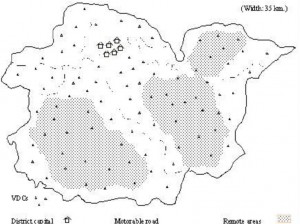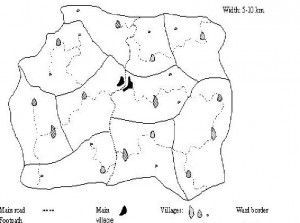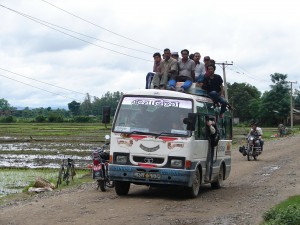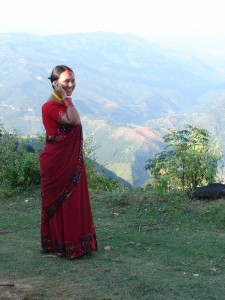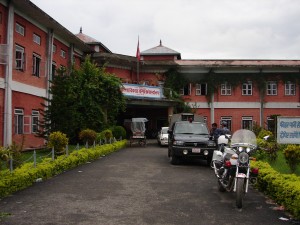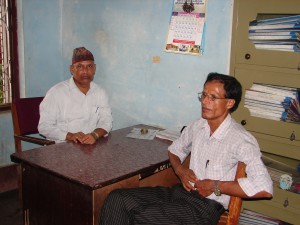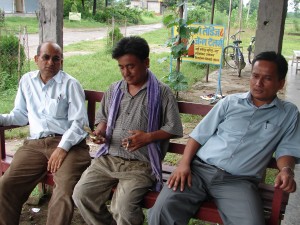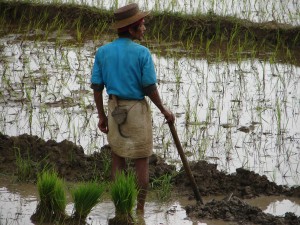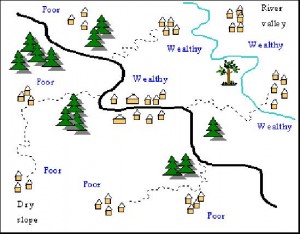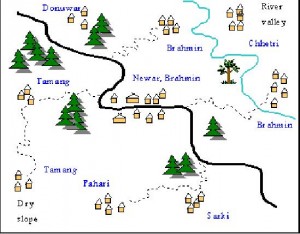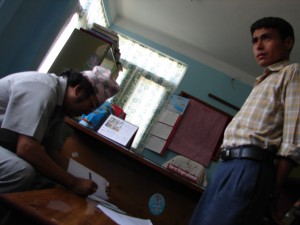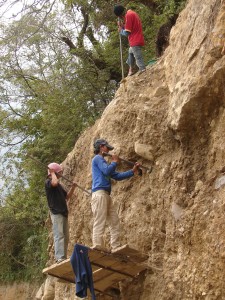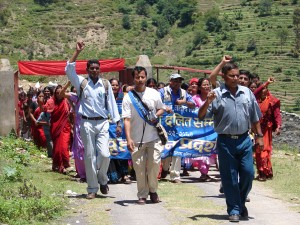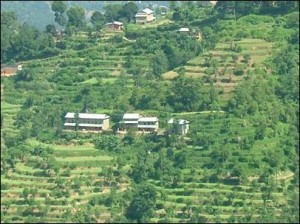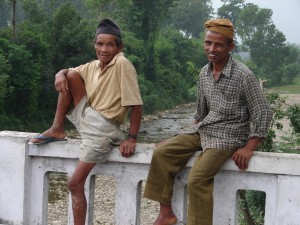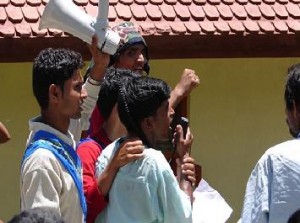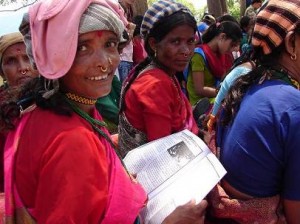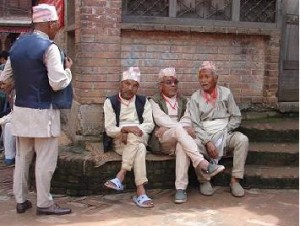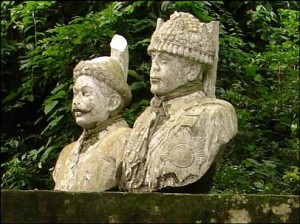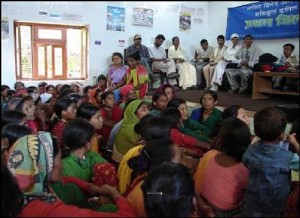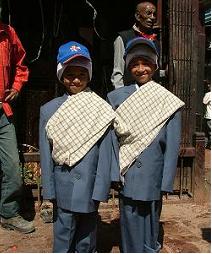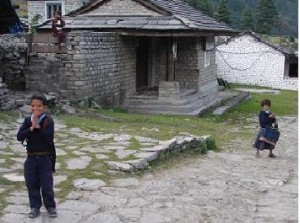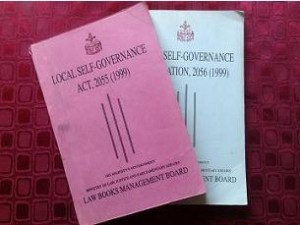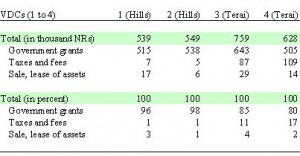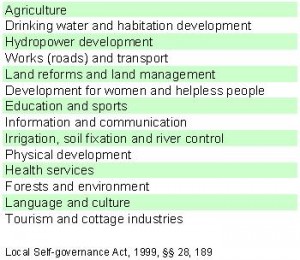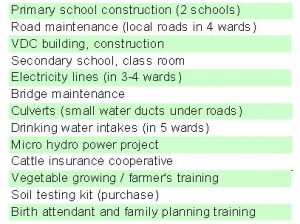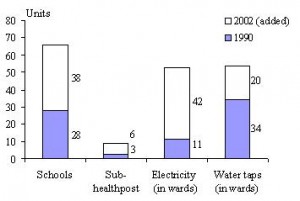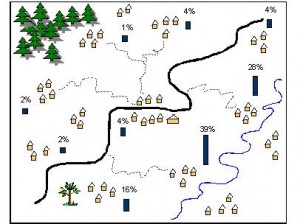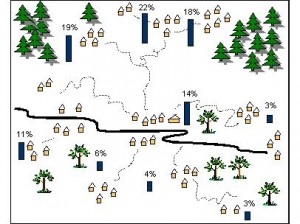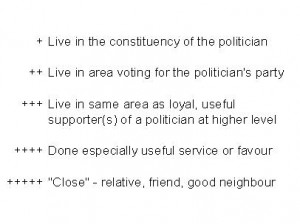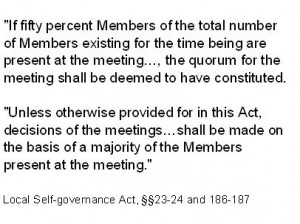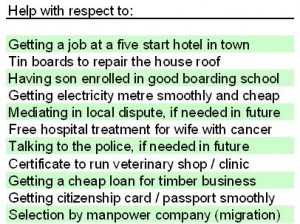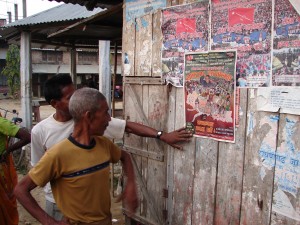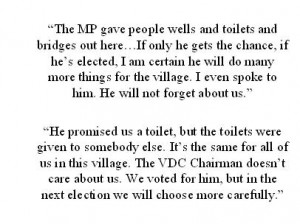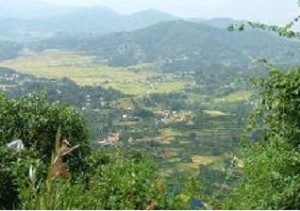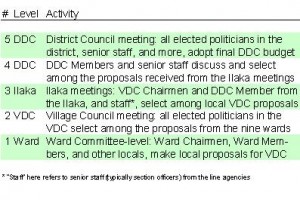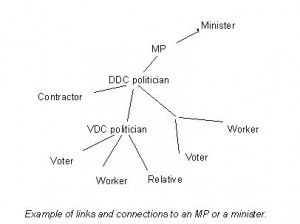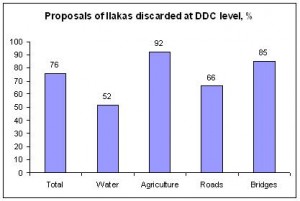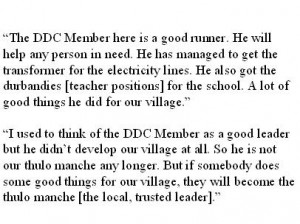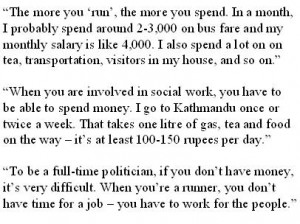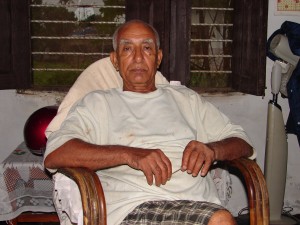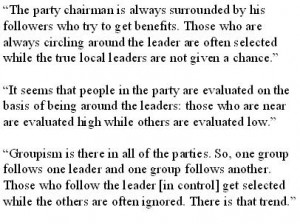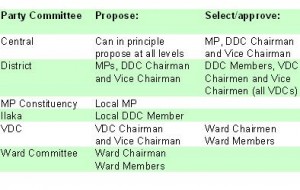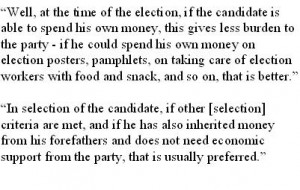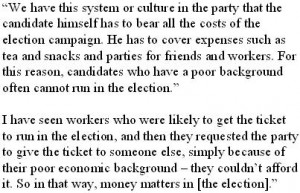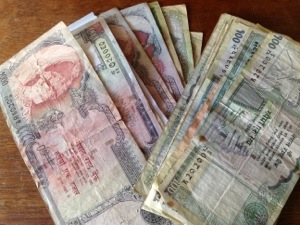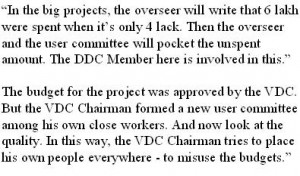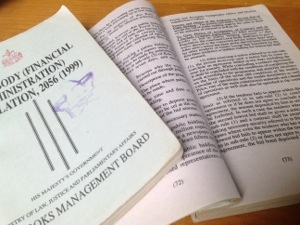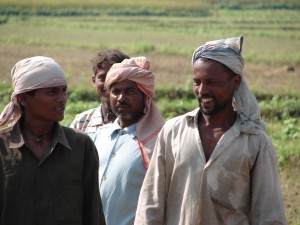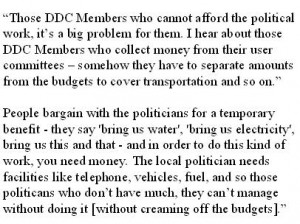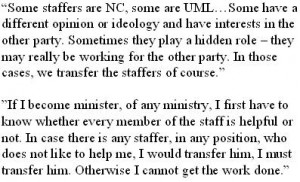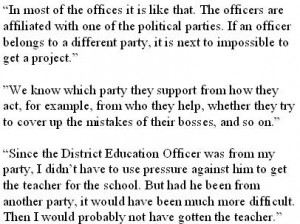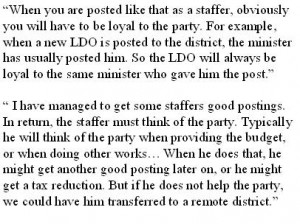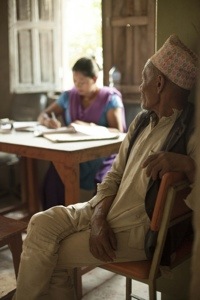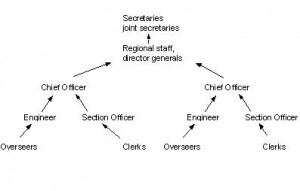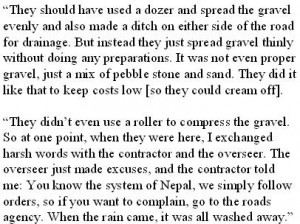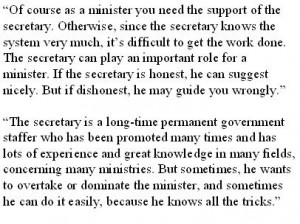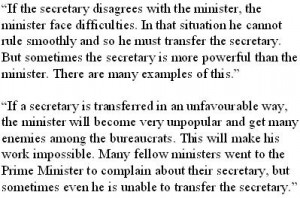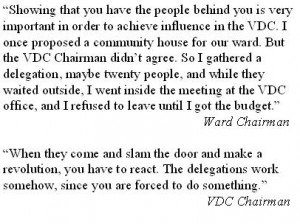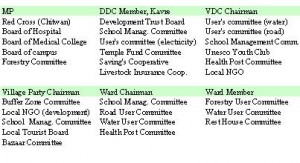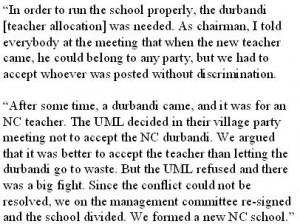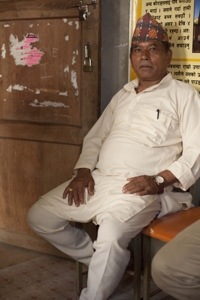What do we mean by local politics? Well, all the stuff that takes place in and around local government bodies and local party branches. But also a lot of what’s going on as politicians at district and village level interact and engage with government and party offices in Kathmandu.
This crash course is not necessarily the “whole story” or even the correct one. Indeed, local politics is complex and full of surprises once you actually meet the politicians themselves and the people they interact with. Go to any village and you sometimes get surprised, at least we are time and again.
We’ll be adding to the sections of this crash course along the way and maybe even new sections. Feel like sharing some of your insights – or correcting some of our observations? We’d love to post your input! The idea of this compilation is not to conclude but to initiate an interactive web-page.
We believe that it’s good to know about politics where the far majority of the country’s population live – in the districts and villages. This crash course is not made with any particular target group in mind but is simply for anybody who’s interested to know about Nepalese politics or to change it.
If you know a lot already, please feel welcome to add to the crash course. If you don’t, we hope you’ll find it informative and entertaining. Just scroll down and/or click on the headlines below – enjoy!
List of Contents
Chapter 1…………………………………………..The Setting: Some Framework Conditions
Chapter 2…………………………………………..Actors and Players in Local Politics
Chapter 3…………………………………………..Needs and Interests
Chapter 4…………………………………………..Values and Norms
Chapter 5…………………………………………..Capacity and Power of Local Governments
Chapter 6…………………………………………..Serving the People: Development Work
Chapter 7…………………………………………..Favouritism in the Distribution of Development
Chapter 8…………………………………………..Decision-making at Formal Meetings
Chapter 9…………………………………………..Serving the People: Personal Benefits
Chapter 10…………………………………………Elections: How Politicians Win Votes
Chapter 11…………………………………………Accessing Resources to Provide Benefits
Chapter 12…………………………………………What Drives Local Politicians
Chapter 13…………………………………………Candidate Selection
Chapter 14…………………………………………Corruption at Local Level: Misappropriation of Resources
Chapter 15…………………………………………Why Misappropriate Resources: Motives of the Politicians
Chapter 16…………………………………………Bureaucracy: Friend and Foe in Local Politics
Chapter 17…………………………………………Struggles for Power: Local Politics at Its Most Intense
Chapter 18…………………………………………Other Aspects of Local Politics – Feel free to Add!
Chapter 19…………………………………………Comparative Observations on Local Politics in Nepal
Chapter 1: The Setting: Some Framework Conditions
It’s simply difficult to jump right into the way local politics in Nepal works without first being a bit familiar with the setting in which it takes place. What do we mean by “setting”? Well, it could include a lot of things. But we are thinking of a handful of conditions. Read here to begin with that.
First thing first: The District
It’s in the districts that local politics takes place. So, first of all, it’s relevant to know what a district looks like. In fact, there is no way of knowing how local politics in Nepal works without first being familiar with the “district” in the countryside: it’s in the districts that most local politics takes place!
How many districts are there? Well, the number is still 75 altogether, like it was when Nepal was first sub-divided into modern administrative districts back under the Partyless Panchayat System. That was in the early 1960s. Nepal even had districts before that. So it’s part of a long tradition.
A district is in turn further sub-divided into a number of “VDCs”. VDCs – the abbreviation of Village Development Committees – are the most immediate context of most Nepalese citizens: it’s where all villagers live! Some will think of VDCs as a kind of rural communes or municipalities.
There is almost 4000 VDCs altogether. They are each comprised of typically one to two dozen villages. The boundaries of the VDCs can often be traced back to the administrative divisions of the 1960s too. Opposite is a drawing of a typical district with a district town surrounded with VDCs.
The district town – there are typically one or two – is the most populated settlement in a district. The VDCs in the surrounding hinterland vary in numbers: there can be anything from thirty or so (e.g. Chitwan) to eighty or more (e.g. Kavre), and some VDCs will be nearby, others more remote.
The population of Nepal’s districts varies but is typically between 200.000 and 300.000. The VDC populations vary just as much: its biggest in the Terai with 10.000 inhabitants or more, smaller in the Hills in the interior, and smallest in the Mountains.
It’s useful to have an image of a VDC. So opposite is a sketch of a typical example. All VDCs are subdivided into nine sub-areas called “wards” each comprised of typically two to three villages.
One of the villages in a VDC is the main village: it’s where you’ll find the high-school, the health post, the VDC office, and most local shops and restaurants. It is in a sense the “capital” of the VDC.
In short, a VDC is like a mini-district. It too has a “capital” and is surrounded with villages, some of which are easy to reach, located near the local “capital” and roads, while others are more remote.
Moving about in a district: Transportation and communication
How do you move about in districts and villages as a local politician? Well, just like everybody else, the answer would be. But we think this part of the setting is important too. Politicians need to move around quite a bit, and anybody who’s tried to reach a remote village knows how that can be!
It can take hours, if not a day or longer, to make it to a village far away from the district town, and so it can for a politician. The difference between most villagers and an active local politician is how often it’s necessary to make the trip either from the village to the town or Kathmandu or back again.
Politicians in Nepal often travel a lot between towns and villages, at least if they are ambitious and trying to be popular locally. What does that mean exactly? Details will follow in a later section. But it’s well-known that politicians make use of links and connections and to do that requires mobility!
It has clearly become easier in recent years to move about within a district in Nepal. Since the 1990s, the roads network has been greatly expanded in many districts, and in many VDCs too. It’s still just bumpy gravel roads in many cases but good enough for a jeep, even a bus, to get through.
It’s also become easier to make contact via telephone. Mobile phone towers or at last telephone cables have been expanded. It’s not uncommon to see a villager with a mobile phone, although the connection might still be slow and unreliable. In addition, the Internet has also reached more areas.
FM stations have increased in geographical coverage too. It’s just a decade ago when we tuned in to one of the first FM stations, based in Kathmandu. Since then, a veritable mushrooming of local radio stations has occurred, and also many villagers can tune in, typically on small transistor radios.
Roads and telephone connections, though, as well as Internet and FM stations, are still concentrated around the towns, in the Terai, and in the most populated Hill areas. In most districts, it still takes a lot of sweat and time to reach most villages. So, it often remains a cumbersome and slow activity.
Organisational Set-up: Local Governments and Party Branches
Politicians at district and village level hold positions as “politicians” (as representatives of their parties) in two main types of organisations: local governments and local party branches. So another basic part of the setting is the organisational set-up of these local bodies and the positions in them.
Local Governments: The DDCs and VDCs
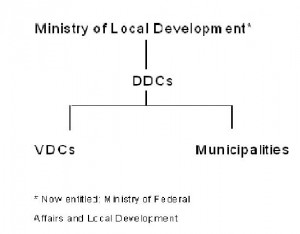 The local governments in a rural district in Nepal can be illustrated as done opposite. The Local Self-governance Act of 1999, which is still the main legal framework, defines three main local bodies: the DDCs, the VDCs, and the local bodies in the bigger district towns, the municipalities.
The local governments in a rural district in Nepal can be illustrated as done opposite. The Local Self-governance Act of 1999, which is still the main legal framework, defines three main local bodies: the DDCs, the VDCs, and the local bodies in the bigger district towns, the municipalities.
Let’s take a quick look at the local bodies one at a time. True enough, the DDCs, the VDCs and the municipalities have been dissolved since 2002 and are still formally left in the hands of local civil servants. Local elections have not been held since 1997! But let’s still begin with what the law says.
DDCs – or District Development Committees – are located in the district towns. The photo opposite shows a DDC office, in Chitwan. Most offices are less glamorous, but that varies. A DDC is the local government of the district as a whole and typically has ten to fifteen members. They include:
The DDC Chairman, the Vice Chairman, and the DDC Members (also called Ilaka Chairmen).
VDCs – or Village Development Committees – are located in the main village in the VDC. In fact, some VDC’s don’t even have an office but meet typically at the headmaster’s office or at the home of the chairman. The VDC is the local government at village level and always has eleven members:
The VDC Chairman, the Vice Chairman, and nine ordinary VDC Members.
The ordinary VDC Members are also called Ward Chairmen because they each chair a local body in their ward: a Ward Committee. This committee includes another four members: the Ward Members.
Municipalities mainly belong to the towns. To limit ourselves, we’ll say less about them. But they are set up like a VDC, only the titles are Mayor, Vice-Mayor, and ordinary municipality members. Moreover, the subdivisions of the municipalities are locally known, not as wards, but as “tole”.
The local governments are of course comprised of more than just the politicians. There is also an administrative staff, although especially in the VDCs it is quite limited. The following is typical:
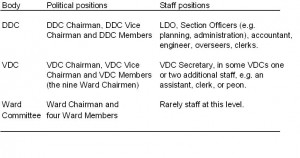 A DDC has a Local Development Officer (LDO) who is the director of the DDC administration. He and most other of the staff, such as the engineer and the planning officer, are deputed by Ministry of Local Development. Some DDCs, though, employ additional staff or have staff funded by donors.
A DDC has a Local Development Officer (LDO) who is the director of the DDC administration. He and most other of the staff, such as the engineer and the planning officer, are deputed by Ministry of Local Development. Some DDCs, though, employ additional staff or have staff funded by donors.
A VDC has a VDC Secretary, and the VDC secretary is also deputed by the Ministry of Local Development. Some VDCs employ one or two additional staff on the basis of their own funds. The typical political and administrative positions in the DDCs and VDCs are summed up above.
Local Party Branches
The organisational set-up of local party branches is the same across most parties at an overall level. There are differences in the details, such as meeting procedures and the like. But the formal structure of local party committees under the Central Party Committees in Kathmandu is the same.
The political parties in Nepal have a set up of local party committees at levels corresponding with the levels of local government and the main constituencies. Let’s briefly list the constituencies.
The biggest constituency is the district itself. This is where the DDC Chairman and Vice Chairman are elected. A district is in turn subdivided into a handful of parliamentary constituencies; a bigger number of “Ilakas” in which the DDC Members are elected; and finally the VDCs and the wards.
The parties don’t have formal committees at all levels. But they all have the following two:
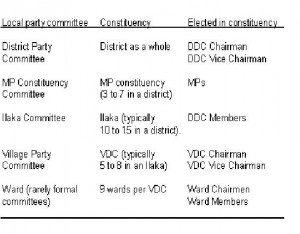 District Party Committees at the level of the DDC and the constituency of the district as a whole. You might not find a district party office, but the bigger parties usually rent a house, flat or room.
District Party Committees at the level of the DDC and the constituency of the district as a whole. You might not find a district party office, but the bigger parties usually rent a house, flat or room.
Village Party Committees at the level of the VDCs and the wider constituency of the VDC. Not least at this level, you’ll rarely find an actual party office. Some local parties simply meet at home.
Two additional party committees are organised by some parties at the intermediary levels. These include “MP Constituency Committees” and “Ilaka Committees”, set up in parallel with the two corresponding constituencies. In many cases, though, these committees are only active in elections.
Chapter 2: Actors and Players in Local Politics
Who are the actors or “players” in local politics in Nepal? Well, there are quite a few. We’ll leave some of them for later. But a set of main categories are good to put on the “map” from the outset.
The Local Politicians
We’ll start with the local politicians themselves. They include, in our sense of the term, all those who strive with more or less ambition to be or stay members of the local governments and/or local party branches. Some politicians are independent, but most belong either to one party or the other.
The social background of Nepal’s local politicians varies. But many people feel that the local politicians – though less than the national politicians – are not representative of the people as a whole. To some extent that’s true. Many local politicians are, say, better off than most villagers.
Indeed, it is a general pattern that the local politicians, especially at and above the level of VDC Chairman, belong to the more privileged groups of the local community. The typical local politician is a middle-aged man, fairly well educated and well-off (but not necessarily rich), and a high caste.
This does not mean that women, for example, are not represented at all. But women are rare above the level of Ward Member, even among the Village Party members. In the same way, politicians from a poor ethnic or lower caste background, and also the less educated, are rare above VDC level.
Why local politicians are recruited mainly from the better off segments of the community is a complex issue. It has to do with the money and time required to be in politics: not everybody can afford it. But it’s also a result of whom voters support and other things. We’ll look at that later.
How many are the local politicians? Well, out of the total population in a district, very few. Take any district or VDC and they’ll constitute a small minority. Of course, the number of DDC and VDC members is extremely limited compared to the population, and so is the active party members.
It’s relevant to make a distinction here between active and general party members. The active members typically work for the party both in and between elections. They are the “party workers”. The general members, in contrast, are only occasionally or never active. They are just supporters.
The table opposite illustrates how varied the number of members in a political party can be at VDC level. It lists the number of active and general members in different Village Party Committees in VDCs with 2,000 to 10,000 inhabitants. In most local party branches you’ll find similar numbers.
The number of active members in a District Party Committee also includes only a small part of the local population. The committee typically counts two or three dozen members. It’s nevertheless this relatively small group of people – the local politicians – whom many locals expect so much from.
Townsmen and Villagers
Local politicians are directly confronted with the locals that are affected by their actions. In fact, it’s difficult for many local politicians to walk down the district town or trough the VDC without being greeted or confronted by people who know them. Townsmen and villagers will often address them.
It’s relevant in a crash course on local politics in Nepal also to have an image of who the locals are. It is common to talk about the politicians, on one side of the counter, and the people on the other, and to insist that that the “politicians” ought to serve the “people”. But who are the people actually?
The people are of course not just a grey mass but a mix of all kinds of demographic and socio-economic segments. Moreover, they make up a patchwork of more or less visible cultural groups. We are here thinking of the different castes and ethnic groups that the population are divided into.
Outside the district town, the far majority of the people are farmers, if that’s not too big a word. Some would rather use the term peasants. Most of the farmers till merely half a hectare or so of land! Of course, the average acreage in a district varies across the country, but few own more.
Villagers, though, are not all small-scale farmers – or peasants – who are able to merely till for their own subsistence. There are also a few big farmers who own many hectares: farmers with access to irrigation and who harvest twice a year, tilling enough to make their farm into a veritable business.
Opposite is a sketch of a VDC which illustrates where you’ll often find rich and poor in a VDC in the Hills. The big farmers typically live in the valleys along the rivers, while the poor peasants reside on the dry slopes. Shop-owners and other wealthy villagers usually stay in the main village.
How much crops the land can yield varies across a VDC. It is inevitable, in turn, that those villages located where the land is rich and irrigable are better off than those situated where the land is less fertile. In the Terai, the poorest villages are sometimes those on the banks of flood-prone rivers.
This geographical pattern between rich and poor villages often has a cultural layer. The wealthiest villages are typically inhabited by high castes or other historically (and locally) privileged groups, such as Newars or Yadavs, while ethnic groups and low castes predominate in the poor villages.
The sketch opposite illustrates this pattern in the VDC just depicted. See how the rich villages are inhabited by Brahmins and Chhetris and the main village mainly by Newar (shop-owners) while the Tamangs and Paharis, Sarkis and Donuwars, live in the poor villages? This is a typical pattern.
This does not mean, though, that all high castes are rich and all the lower castes and ethnic groups are poor. In fact, we have met many Brahmin households that were just as poor as ethnic and lower caste households often are, and vice versa. But the overall picture typically is as it’s now shown.
The People in a District
Take anything from thirty to eighty or more VDCs, put them next to each other in some cluster, and you’ll have an image of the settlements in a district outside the district towns: villages that are located some near to the towns and others remote and some in better off and others in poorer areas.
The castes and ethnic groups can be even more diverse once you scale up and look at a district as a whole. Meanwhile, the geographical and cultural pattern between rich and poor is in principle the same. It’s true that remittances has affected this pattern, but on the whole it is still very prominent.
The level of education varies according to this general pattern, too. On the whole, the literacy rate in Nepal’s districts varies from around 30 percent up to around 70 percent, and the highest level of education is in the better off high caste villages while the lowest is in the poorest low-caste villages.
Most locals are peasants but in any VDC you’ll also find other traditional occupations. There will be retailers and teashops, typically a carpenter and a black-smith, perhaps a bike-mechanic, a tailor and shoemaker, and a guesthouse owner, as well as porters, to name the most common trades.
More innovative sectors are also found: entrepreneurs who have entered more novel businesses. Take local transportation businesses, as one example, and local cottage industries such as home moulding of concrete elements for house construction or manufacturing of candy, as another.
In the district town, politicians are faced with locals in a range of additional occupations. There are administrative staff working at the ministries’ local branch offices – the line agencies – as well as contractors and a diversity of other businessmen, and in many districts people working with NGOs.
Teachers, health workers, and policemen are the biggest categories of field personnel. Indeed, it’s staffers in these categories that villagers come into contact with the most. Who do the politicians, in turn, interact with? Well, it varies a lot. But it’s useful to have a look at some of the main actors.
Line agency staffers
The line agencies are extensions of the ministries, and just like the DDC office they are typically located in the district town. It varies between districts how many ministries are represented. But there usually is a line agency for all the development-oriented ministries like education and health.
The districts we know of have line agencies for at least the following sectors: education and health, agriculture and livestock, electricity and water resource, tele-communication, roads and transportation, as well as a land registration office and the CDO’s office under the Home Ministry.
The line agencies are typically smaller offices – each usually with its own building – comprised of one or two dozen office staff and a variable number of field staff. They actually have only limited formal autonomy: they can’t decide much on their own, but have to do what the ministry instructs.
In practice, however, that’s only true to a certain extent. Even the head of a line agency – called the Chief Officer – is not allowed to change much in the plans and budgets without prior approval from the ministry. There is little discretion. But informally, some Chief Officers quite often do it anyway.
The biggest source of funding in a district for development purposes next to the DDC or perhaps a donor-funded local NGO are the line agencies. If you’re a local and want more money for schools or the local health post, electricity lines or a water intake, roads or bridges, this is the place to go.
It’s also true, though, that line agencies – like most other offices in Nepal – are typically under-funded. A line agency has a general budget that covers rent, salaries, and other basic operational costs, and then a development budget for the actual activities. Very often, the latter is very small.
Moreover, even if a line agency has a big development budget, it’s not always easy to get a share. There’s an element of politics involved. You’ll know just by watching the daily activity at a line agency: many local politicians go there. We’ll say more about the political role of the staffers later.
Contractors and Other Businesses
Contractors are another important category of actors on the “stage” of local politics. They are comprised of local businessmen who work on contract both for private and government customers. There are A, B and C contractors defined according to the size of contracts they are licensed to take.
DDCs, line agencies, sometimes even VDCs, hold public tenders in which the local contractors bid. Most of these contracts are either for road tax collection or various public works. In fact, for many contractors it’s crucial to their economic survival to win at least one or two of these tenders a year.
In some districts, many contractors are members of a local Contractor’s Associations. The purpose is not only, say, to discuss common issues or exchange experiences, but also to arrange bids so that each contractor will be able to win at least one tender a year. In that sense some work like a cartel.
The formal system of tender selection is Nepal is the same as in many other countries. Basically, it’s required that the tender is publicly announced and the tender submission date is fixed well in advance, and also that the bids are assessed according to objective criteria. That’s as it should be.
However, it is common that informal links and connections also play a role in determining who gets the contracts. Competition is tough – there are many contractors and few contracts to win – and in order to gain over the others, many contractors are seen to enter the stage of local politics as well.
Other types of businessmen do it too. What kind of political game is it, more exactly? Well, it’s common for contractors as well as other businessmen – from traders to hotel owners – to seek and use links and connections within the political parties as well as the bureaucracy. We’ll see that later.
NGOs
NGOs (non-governmental organisations) mushroomed in Nepal in the 1990s and today there are thousands. Many NGOs have local branches just as there are purely local NGOs. Some local NGOs have a lot of resources due to donor support while others have much less funding at their disposal.
It is well-known that NGOs in Nepal are often associated with political parties. Indeed, in many of the VDCs we have visited over the years it’s common to talk about, say, “NC-NGOs” and “UML-NGOs”. The meaning simply is that some NGOs favour one party and other NGOs favour another.
NGOs have often been labelled core members of “civil society” – a sector which western thinkers have liked to imagine as a sphere being separate from “politics” and “government”. But of course, in Nepal (and in so many other countries) it is not. Many NGOs are prominent players in politics.
Local NGOs also have a portfolio of local groups in many cases through which they carry out their activities. It could be savings groups, women’s groups, or farmer’s groups, or some other category. Such groups have sometimes enabled less privileged villagers to improve their skills and livelihood.
But it’s also true that party-affiliated NGOs have mobilised groups at village level with political intentions. Indeed, just imagine how useful an array of local savings groups can be if distributed throughout a district. Come the election, for example, and they can all be mobilised to help win it.
Schools and Student Unions
Schools have been part of the political game in Nepal too for many years. Indeed, under the resistance against the Panchayat System from the 1960s to the 1980s, teachers and the students they mobilised played a central role in generating support against the regime. They were at the front line.
In the 1990s politics continued to play a role at many schools and it often still does today. We have visited VDCs where locals even know the local schools by a party colour. One school would be “NC” and another, say, “UML”. What does this mean exactly? Well, the teachers support a party!
Parties who enjoy the support of teachers in their constituencies have a great advantage. First of all, it’s well-known that teachers can influence their pupils. We have visited VDCs where some felt that the high-school was nothing less than a political playground and a base for recruiting young cadres.
Student unions with party affiliations indeed exist on many high schools and recruitment of young students happens trough them down to grade 7 or 8. Is that unusual, though: to see young people at schools joining a student union and developing political identity? Not exactly. It happens all over.
However, it’s not in all countries that students are that young when they join, nor that schools are known by a party colour. Indeed, we’re not talking about all schools in Nepal, let alone all teachers and students. Moreover, the intensity of the political activities vary over time. But schools matter.
The most unlikely organisations, such as high-schools as we have now seen, can be entangled in the game of local politics. More organisations could easily be added to the list. Take user committees, dairy cooperatives, or insurance funds, even local temple committees, and you’ll often be surprised!
Chapter 3: Needs and Interests
What are the needs of the people of Nepal? Many would promptly answer: “development”! Or they would say “democracy” because only with “democracy” can we ever achieve “development”, or something like that. Indeed, this is not wrong: since so many people will say this, it’s clearly a need.
But it’s also clear that needs in a district can be very diverse. Just go to any VDC and visit any two wards within it. Chances are that in one ward, they’ll ask for a school or electricity lines, while in the other their biggest need is, say, a water intake or a better road. Rarely will the need be the same.
Why is that the case, one could wonder, since two wards could just as well have the same needs and pursue those needs together? After all, if located near each other, they could have their main needs in common. Well, they sometimes do. But often, the most urgent need is specific to the locality.
The needs in Nepal’s districts and VDCs are to a large extent geographically determined. In a way it’s only natural. Villagers mostly stay in the same place for years – in the village – and their needs are typically about services and infrastructure, resources and opportunities, in their own community.
That’s not to say that everybody will always prioritise the same need even within the same ward. Just think of the household who has a young son looking for a job? It’s not difficult to imagine what they might be looking for. Or consider the household whose children are still going to school.
However, there will very often be a need which most villagers share, and it will often vary from one ward to another. Indeed, it will also vary greatly from VDC to VDC. One VDC may mainly need a road or electricity, another may put school renovation on top of the list, maybe a third a health post.
In other words, the politicians will be faced with many different needs across different VDCs. In the district town, the same pattern will typically apply as you visit the different neighbourhoods or tole.
We will call this the “geographical aspect” of people’s needs, and it plays a big role in local politics. There is also the “individual aspect” of people’s needs. Like everywhere else, there are groups and individuals with their own needs. Just think of the contractor who might need help to get a contract!
It is, in fact, difficult to delineate the type of needs that politicians in Nepal can be presented with. Foreigners who think of politics as a field of “public debate” and “elections” are often surprised by it. Locals will ask politicians for help in almost any matter. Just check out the list of needs opposite.
We once made a survey and almost everybody said it was common to ask a politician for a job or help in a neighbourhood conflict. If you can’t cover the bill at the hospital or are in trouble with the police, you typically ask a politician for help too, if you have the opportunity. The list just goes on.
Chapter 4: Values and Norms
What values and norms ought to regulate the game of local politics in Nepal (and politics at the central level for that matter)? Many would immediately cite values and norms associated with “development” and “democracy”, such as equality, the common interest, accountability, and so on.
Ask anybody and they’ll usually say that in the overall the politicians ought to serve the “people” as a whole. Many would add, in combination with this overall value, a wish that the politicians would especially focus on those most in need: the “poor” and “excluded”, “landless” and “low castes”.
Many locals will insist that the politicians should act, not like “politicians” who always “struggle for power”, but instead like “social workers” who will serve anybody in need. You’ll often hear that term out in the districts and villages: to be a “social worker” is often considered a value of its own.
It’s common to say that the politicians must follow “democratic” values and norms. Many will say that “democracy” is a value, urging the politicians to respect the requisite “democratic” norms. In short, it’s common to voice support for values and norms associated with western societal models.
Values and Norms Linked to Family and Friends
It’s also well-known, however, that values and norms rooted in people’s closest relationships often mean just as much or even more. In fact, it’s impossible to understand local politics in Nepal without being familiar with these values and norms. The first that many mention is “afno manche”.
“Afno manche” is not anything mysterious or even unusual. You’ll find something like it in many other countries, not least in the less “developed” parts of the world. Afno manche means “one’s own people” and it refers to the circle of family, relatives and friends with whom you are “close”.
It’s not enough to have a blood relationship. After all, there could be an uncle who doesn’t really care about you. “Close” hear refers to a relationship that involves a mutual feeling of loyalty and obligation. Typically, though, this type of feeling is strongest among family and close relatives.
The status and well-being of the family and other associates is a value, and the corresponding norm is to help one another. The family – not just mum and dad, uncles and cousins, but also the extended family – is simply of great importance. The norm of helping one another therefore plays a big role.
What is that norm, more precisely? In short, it is to help your relatives and friends if you can, and to be able to expect that they’ll help you in return, when you’re in trouble and need to resort to your “own people”. In a society with little social welfare by the government, this is a crucial relationship!
Values and Norms Linked to “Big People”
It’s critical that we include another set of old values and norms in this crash course too. Imagine if your relatives or friends simply lack the resources or the position to help you in a certain matter. What would you do? Well, what’s common to do in Nepal is to try and approach a “thulo manche”.
The term thulo manche means “big people” in the sense: wealthier, more powerful or influential than you. It’s someone who can solve problems for others based on a position at a higher level. It’s common to consider not least a powerful politician a thulo manche. So, you approach such a person.
It’s an age-old practice in Nepal, moreover, to attempt to develop good relations with big people. If you think the local VDC Chairman, the landlord, the MP, perhaps the Chief Officer, or a wealthy businessman in town, could help you with something, it might be good to offer him a service first!
The age-old practice is, in other words, to try to become “close” with big people by offering either a service or something tangible when the opportunity arises, hoping for some reciprocity later on. The practice even has a term. At least, it’s often referred to as “chakari” or, in a lose translation, flattery.
Flattery in this sense is everywhere. Go to any district, visit any office or the home of any powerful politician, and you’ll eventually get a chance to see the behaviour first hand. If you ever see a party worker carrying the MP’s bag, or a junior officer rushing to fetch tea, you’ve had a glimpse of it.
The practice is to nurture a relationship with big people that approximates as closely as possible that among one’s “own people”. Indeed, when a “big man” helped out several times, the less privileged recipient – the “small man” – will often begin to refer to his “patron” as one of his afno manche!
But what’s in it for the big man: the thulo manche? Well, in a common term, he’ll gain “patronage” in the community: he’ll have an array of small people under him who will not only owe favours to him but also have a strong motivation to return those favours. Of course that can be a big advantage.
Values and Norms: More to Consider
We couldn’t even hope to cover all the values and norms that pervade the context of local politics in Nepal. In fact, the game of local politics takes place amidst a huge mix of values and norms. Just think of all the castes and ethnic groups who each have certain values and norms particular to them.
It’s clear by now that a district is comprised of a great plethora of circles of afno manche and of relationships between big people and small people. In our experience, all these circles and relationships can be entangled with each other in so many ways that we could speak of “networks”.
The values and norms that play a role inside these networks, but also outside them, include more than described so far. For example, young people usually hesitate to object to the commands of older ones: young must respect the senior. That’s the norm! The same norm applies in local politics.
It’s a strong aspect of any relations between people of unequal status that one must show respect. Observe subordinates interacting with superiors in any context and it’ll be evident at once: you’ll very rarely hear a subordinate object or even suggest alternative options unless he’s asked directly.
We would be amiss without also adding values and norms in gender relations. Indeed, most local politicians are men. In fact, we have rarely met women in any positions except at the lowest level, in the wards. Is that because women are discriminated against? Well, that’s part of the answer.
One thing is the role men and women are brought up to play in the family and in society, though, another is discrimination. Take the term “sari politics”. It’s well-known in Nepali politics that if you want to influence a powerful politician, go to his home and ask his wife (who wears sari) to talk to him!
It’s even more important to note, we think, that all these values and norms about showing respect – between young and old, subordinates and superiors, men and women – vary between families and other relationships. Moreover – slowly – change is clearly taking place in many values and norms.
But why look at all these values and norms? Well, what is customary or the “right thing to do” can play a big role – though it not always does – in decision-making and everyday interaction in local politics: who politicians serve or favour, who they listen to, who is obeyed – can be affected by it.
Chapter 5: Capacity and Power of Local Governments
The local parties are all urged to use the capacity and power of the local governments to serve the people as a whole. That’s a major public demand. Ask anybody, and most will reply on a general level that the local politicians ought to use their power to make “development” across the district.
But what is the capacity and power of local governments in Nepal to “develop” a whole district: to meet all the needs and interests for roads, electricity, drinking water, schools, health posts, and so on? Well, we’ll have to distinguish here between two periods: before and after the fall of 2002.
Capacity and Power of Elected Local Governments
Up until 2002, which was a year when not only local governments but also parliament itself were dissolved and replaced with appointed officials, their capacity and power did increase. In fact, much was achieved in the area of “devolution”: the transfer of power and resources to the local level.
A UML-led government took the first step in 1994 as it raised the annual block-grant for the VDCs from less than 1 to 3 lakh. One year later, the successive NC government trumped this gesture by raising the amount to 5 lakh or 500,000 rupees. Also the DDC grants were raised during this period.
In addition to that, and strongly promoted by donor agencies, the Local Authorities Act was replaced with the Local Self-governance Act. This act gave the DDCs and VDCs certain further powers, including powers to collect more taxes and to organise committees to carry out the work.
However, the DDCs and VDCs remained left not least with grossly inadequate financial capacity to effectively handle the responsibilities assigned to them and to meet local needs and expectations. Indeed, the 5 lakh to the VDCs was a major improvement. But in a whole VDC it’s a small amount.
5 lakh is enough to build a couple of average size classrooms and pave a stretch of road. However, if what you want is to provide services and infrastructure in all the nine wards in a VDC, and if you’re also trying to make bigger infrastructure like a high-school or a health post, it is inadequate.
As a result, it often takes several years to complete a bigger project in a VDC simply because the 5 lakh will only cover part of it. Take a school building. One year the VDC will do the walls and part of the roof; the next put in furniture and start teaching; and the third year maybe install the toilets.
It’s true that a strengthening of the fiscal powers of the local governments occurred. The Local Self-governance Act gave the DDCs and VDCs authority to raise and keep more and new types of local revenue. But on the whole, local revenue, especially at VDC level, has remained quite limited.
The DDCs collect revenue mainly from road tax and extraction of raw materials on DDC land. In most cases, contractors are given the tasks and pay a percentage of the revenues back to the DDC. VDCs mainly collect land tax. But due to a small tax base in many areas, local revenues are small.
In sum, most DDCs and VDCs lack the financial resources to effectively meet the numerous and typically basic needs in their areas: needs such as more classrooms, health posts, teachers and medicine, electricity and drinking water, and much more. Every year many needs are left unmet!
Grossly Inadequate: Staff Capacity
It’s not only the financial resources that are inadequate. So is the staff. Some DDCs and a few VDCs have the funds to employ staff. But most staff is posted by and under the Ministry of Local Development. Some DDCs have hired, say, a few project officers, but otherwise it’s very limited.
It requires much time, as well as vehicles, fuel, and manpower, for a DDC to cover the district as a whole. A DDC administration is supposed to frequently go to the VDCs and inspect ongoing projects, evaluate the work done, supervise and monitor. However, most lack the capacity to do so.
A DDC would usually have one engineer, two or three overseers, and perhaps a few sub-overseers, all deputed by Ministry of Local Development. That’s it for technical staff. Indeed, if they all work at full intensity, perhaps they might be able to cover a large chunk of the district. But they rarely do.
To cover the whole district requires not only staff but also vehicles and fuel. DDCs often lack both in adequate quantities. If three overseers have to share one motorbike, and if the budget is not enough to fill the tank every day, well, covering the whole district is bound to take a lot of time.
VDCs usually don’t have technical staff and must go to the DDC in order to obtain assistance, simply because they lack funds to employ their own. There are many good reasons why the VDCs are not given funds to cover expenses like staff salaries. But the fact is that it limits VDC capacity.
Capacity and Power after 2002
The issue of capacity is essentially the same today as prior to 2002. Of course, a lot has happened in between. The king – Gyenendra – stepped down after a failed attempt (or whatever it was) to take power, and a general election for a Constituent Assembly was held in 2008 which the Maoists won.
The 2008 general election was indeed followed by a perhaps surprising decision to postpone the local elections. It was decided to set up so-called “All-party Committees” instead each reflecting the composition of the Constituent Assembly. But these committees were dissolved in January 2012.
Politicians in the all-party committees engaged in corruption. They colluded internally and possibly even with LDOs and VDC secretaries to misuse local budgets and other resources. In the media, it was portrayed as a free-for-all. Somehow, the all-party committees had been able to gain influence.
The LDOs and the VDC secretaries had been in charge of the DDCs and VDCs since the kings’ coup in 2002. They still were and the all-party committees were only supposed to act as a kind of advisory bodies. The local politicians involved in them, however, engaged in much more than that.
Many observers in Kathmandu felt that local corruption had grown out of control and applauded the Minister of Local Development when he followed a CIAA recommendation and dissolved the all-party committees. Indeed, the all party committees remain dissolved also at the time of writing.
It’s true that more resources are now available to the local governments. In 2011, the government made an additional 5 lakh available to each VDC. However, the VDCs must apply to the local LDO for this grant – project by project. So, as a self-governing body, the VDCs still only have 5 lakh.
The DDC grants have also been enlarged in recent years, but mainly in the form of donor funds. The DDCs must often apply for these funds and much of it is earmarked for specific sectors or purposes. So, the power of the DDCs to use many of these grants is also attached with conditions.
Chapter 6: Serving the People: Development Work
The DDCs and VDCs have made a lot “development work” despite the lack of budget and staff. What is “a lot”? Well, the local achievements vary, but in many districts and VDCs they have at least provided many more services and infrastructure after 1990 than in any previous decade.
The DDCs and VDCs have planned and implemented development work that have served many people. They have built roads and bridges, schools and health posts, electricity lines and water intakes, river dikes and irrigation canals, and carried out softer activities like farmer’s trainings.
What types of development work have DDCs and VDCs been required to carry out under the law? Well, the Local Self-governance Act lists a whole range of sectors which spans from roads and bridges over education and health to electricity, water resources, and even tourism development!
The development work of the DDCs and VDCs in many districts and VDCs is not much relative to the needs of the people. However, it would be wrong to say, as some do, that the local bodies have not provided any development at all. Despite the lack of capacity, and despite misuse of resources, quite a lot of work has been done.
In all DDCs and VDCs that we have visited, at least, local records and field observations clearly show that a significant amount of development work has been done. The list opposite is just one example. It shows the variety of development work carried out in one VDC over a five-year period.
In 2002 – the year elected local governments were dissolved – we visited a number of VDCs to look at their achievements: how many roads, schools, health posts, electricity lines and water intakes had been built since “democracy” began in 1990. In these VDCs, quite a lot was done, as shown left.
It’s also true that some DDCs and VDCs have done much less. Indeed, it varies. Moreover, line agencies, NGOs, and donors implementing programmes directly in the community, also account for many of the achievements. But many local bodies have provided more development than earlier.
Chapter 7: Favouritism in the Distribution of Development
Have the people as a whole benefited from the development work or only some sections of the local community? In many areas, some groups and people have clearly benefited more than others. This is a well-known and much criticised aspect of local government. Favouritism plays a very big role.
In fact, the Local Self-governance Act requires the DDCs and VDCs to serve the local people as a whole and only to give special attention to less privileged groups. They must give priority notably to ethnic groups and lower castes, landless and the unemployed, and to women, children and elders.
Time and again, however, the power-holders in the DDCs and VDCs have favoured other groups instead. Indeed, go to any district or VDC, even to the most “developed” ones, and you’ll often find a quite skewed distribution in favour of groups and people that are not among the least privileged.
Just look at the example opposite from a VDC that we once visited. Check out the distribution of the 5 lakh on development work meant for individual wards over a five-year period. It’s readily clear that in this VDC, there was a tendency to favour two or three wards.
Were the favoured wards in this VDC the “poorest” or most “marginalized”? Far from it. One of the wards was even the wealthiest, located by the river where the big landlords lived. The other wards were under the leadership of Ward Chairmen who were, in a term, “close” to the VDC Chairman.
There are also cases in which areas where the least privileged live were favoured. The illustration opposite shows the case of three wards inhabited by Tamangs – a generally less privileged ethnic group in the Hills. But two other wards were almost just as poor in this VDC and yet largely ignored in the allocation of the budget.
So, roads are gravelled and classrooms are built, health posts are constructed and electricity lines set up. But the power-holders in the DDCs and VDCs far from always decide who should benefit based on the objective criteria in the law. Frequently, it is more informal, political considerations that weigh more.
Who is favoured
It’s well-known that local politicians (like many national politicians) to some extent tend to favour their “own people”: their afno manche. DDC Members do more work, say, for their own VDC, VDC Chairmen do more for their own ward, and Ward Chairmen do more for their own village.
But favouritism is more complex than that with respect to the categories of favoured people. There is a term in Nepali politics called “area politics” or: politics focused on the constituency. Indeed, a very common proclivity among local politicians is, first of all, to favour their own constituency.
Moreover, it’s also typical not to serve everybody in the constituency to the same degree. In any constituency, locals will tell you that some areas are, say, “NC” and others “UML”, meaning that different areas are supportive of different parties, and the politicians tend to favour their areas more.
Does this mean, though, that you’ll get a lot of development work to your area just as long as the party you support is in power? Far from always. Chances are better but you might be set aside in favour of areas in which the most loyal and useful supporters of politicians at higher levels reside.
MPs, DDC Members, and other politicians at higher levels, have a tendency to favour those areas in which local supporters able to promote their interests locally live. In short, they’ll favour a local politician who always looks after their interest – e.g. local electoral support – in his particular area.
Businessmen, civil servants, and many other individuals who have, for instance, donated money to the politician, or done some other especially useful service, are another favoured category. The nature of the benefits they receive, however, is rarely development work, as we’ll see further below.
It’s also true, though, that family and friends are usually favoured the most: it’s where the politicians and his closest “afno manche” live that the largest share of the development budget is often spent. Indeed, there are exceptions. But it is common to find a skewed distribution in favour of the “closest” ones.
Chapter 8: Decision-making at Formal Meetings
How is it possible for the politicians in majority in a DDC or VDC to channel the biggest share of the budget for development to their supporters – and to do so following a norm of favouritism rather than the formal criteria spelled out in the Local Self-governance Act? Well, the answer requires a look at formal meetings.
The DDCs and VDCs – prior to their dissolution as elected local bodies – were typically comprised of politicians from at least two parties, often three and even four. In the 1990s, NC or UML were in majority in most DDCs and VDCs. Today, if local elections were held, it might be different parties.
The elected DDC and VDC members from the different parties must hold two types of formal meetings. One type is monthly DDC and VDC meetings to discuss current matters while the other type takes place once or twice a year – a District Council and Village Council meeting – above all to make the budget.
The Local Self-governance Act stipulates, in turn, that the decisions are to be made on the basis of a simple majority vote. So, in short, the party in majority (or sometimes two parties in coalition) has the formal and legal prerogative to make all the decisions at the formal meetings.
The result of this decision-making rule is as follows: since in many DDCs and VDCs one party sits on more than fifty percent of the seats, one party also makes all the decisions. The law entitles it to do so! Or when more parties are represented, a two-party coalition dominates.
Just take one example from a Village Council meeting in a VDC in Kavre. You can read it here in detail – and it’s just one of many. The minority – in this case NC – would raise questions and ultimately start to shout in protest. But the majority – here the UML – would still decide the budget.
Does this mean that “debate” and “compromise” never plays a role in the decision-making? Not entirely. Compromise and even cooperation does happen under certain circumstances, as we’ll show later. But on the whole, in the DDCs and VDCs the simple majority rule is often used to the fullest.
Chapter 9: Serving the People: Personal Benefits
The DDCs and VDCs are legally defined as local government bodies that carry out their activities in a planned and organised manner as coherent bodies. However, until they were dissolved, DDCs and VDCs were in practice comprised of local politicians who indeed each had their own constituencies.
Townsmen and villagers in Nepal typically look to their local politician as a representative, not necessarily of the “party” or the “people” alone, but also of their constituency and themselves as
voters. If you have supported a local politician, even an MP, somehow you expect something back.
Politicians, however, are not only expected by local supporters to provide benefits in the form of development. It’s also common to expect other and more personal benefits. Just look at the list opposite. It shows the type of personal benefits – tangibles and services – that villagers we once asked mentioned.
Townsmen and villagers frequently go to the local politicians in their areas with all kinds of needs. They might need a job for their son – so they’ll ask the politician for help with that; or they might need help in getting a civic document, cover the hospital bill, or get out of trouble with the police.
Politicians at all levels of a district, at least in our experience, frequently spend a lot of time on trying to meet these personal needs. Are they required to do so according to the law? Not at all! But they do it, nevertheless. You’ll often see local politicians on their way somewhere to meet a need.
It’s not everybody who can expect help of this kind. Once again, like in the case of development work, favouritism plays a big role in who gets what. It’s mainly supporters – voters, party workers, especially loyal politicians, contributors, family and friends, and so on – who can expect such help.
But how do the politicians learn about the personal needs of supporters? Well, their supporters go to them and ask for help. Those who are close to a politician from the NC go to him; those who feel like supporters of a UML politician go to him, and if you’re a relative, it’s obvious where you’ll go!
Chapter 10: Elections: How Politicians Win Votes
It’s common to say that voters in a country will support those parties that show commitment to serve the “people”. Elections are won by those who have “performed”! But in Nepal many feel that elections don’t really work like that. Indeed – as this part of the crash course will show – the politicians win votes in diverse ways.
Many people would in principle like power-holders to serve the “common interest”: to do what’s ultimately best for everybody. If the politicians we elect prove to care little about the “people” in practice, then we hold them accountable in the next election. Fair and simple isn’t it!
But it’s also true that the way voters vote is more complicated than that – also in Nepal. Indeed, it’s not least when you look at elections that it’s good to bear in mind that the “people” are not a uniform mass. They consist of many segments and groups whose interests differ.
Many voters in Nepal feel discontent when the politicians promise one thing only to do another: when the politicians they voted for promised to serve the whole VDC only to favour their own ward; or when they pledged to built a school only to spend more time on getting someone a job.
But at the same time, those voters who benefited typically praise the very same politicians and even consider voting for them again! In fact, while politicians who do not serve the “people” in the wider area, or in their constituency as a whole, face criticism from those voters they neglected, they often receive support from the voters they served.
Political parties in any country represent different interests in society, however broad or narrow those interests might be. Take the old social-democratic parties of Europe: they represented the interests of the “working class” – conservative parties those of the “wealthy”.
In contrast, parties in Nepal are not based on the support of wider socio-economic segments. Go to any VDC and you’ll find that some “poor villagers” support one party, some another, and still some a third. How is that possible? Well, “poor villagers” are just not tied up with any single party. They vote for different parties and alternate too.
Politicians in Nepal face voters whose interests are typically not linked mainly to a wider segment in society, such as the “working class” or the “poor villagers”, but to their locality. Sure it’s nice if everybody gets a school, but many voters need it in their village first! In short, the politicians have to win votes village by village. How is it done? Well, let’s look at some of the main methods.
Election Campaign Methods
Politicians in Nepal often promise to meet the “need of the village” – that’s one common campaign method. We have met many local politicians who have told us this, sometimes with regret but always with the explanation that “there is no other way”: whoever promises to meet the need of the village will often win the vote.
Another important method, though, is to make oneself visible in the constituency in between elections. Many politicians say that to win an election, it’s good if you gain a reputation beforehand as a helpful leader – indeed as a social worker – who is approachable.
However, it’s also a common experience that many voters tend to forget earlier performances if a new candidate shows up and delivers weeks before the election. Some politicians will erect a line of electricity poles or gravel a road and locals will vote for this new “big man” in return!
Why don’t the politicians simply promote the party’s official ideology and policy goals? Well, the parties do have official programmes. But since most of the voters know little about ideology, and actually look for much more particular and tangible things, it’s difficult to win votes on that basis alone.
Voters we have talked to in various VDCs typically knew very little about party ideology, even about policy goals. In fact, we once carried out a survey in a number of villages, asking the voters if they knew the difference (ideological or otherwise) between NC and UML. 74 percent didn’t know!
Some voters don’t know whom to vote for whatsoever. They take advice from others known as better informed. Many listen to the local teacher or other “respected persons”; in the ethnic villages, such as the Tamang and Tharu, most vote as the village leader suggests.
Politicians are well aware of this less informed and less confident segment of voters. So they invest a lot of time and resources in trying to win the support of teachers, village leaders, and other “respected persons”, because in that way they might win the votes of those who listen to them.
With other voters, it can be decisive to show that you are one of their “own people”. If you can impress upon a caste or ethnic group, for instance, that you are “their own man”, they’ll support you. It’s also true, though, that voters often give up that support again later if you don’t deliver.
Afno manche and close ties between big people and small people play the biggest role in local elections. More locals will feel “close” to a given candidate than in a general election. At ward level, many politicians will win because many voters were relatives, friends, and good neighbours!
What about “vote buying” – another common campaign method? Indeed, many politicians have told us how regretful they are of vote buying. It’s like raping the people, many say. But it is nonetheless a fact that vote buying occurs. Politicians buy the votes in cash or kind voter by voter or in bulk through electoral middlemen.
Winning a Majority
Politicians in a district or VDC know that to win an election, you need to win the most votes – not all of them – and to be successful in doing that, it’s crucial to be able to alternate between the campaign methods now described. In order to do that, you need to know your constituency and it’s people well. Let’s take an example:
In one VDC we once visited, there were three Tamang wards. The other wards were inhabited by Brahmins, Chhetris and Newars. Three of these wards, located in one end of the VDC, were NC, the other three UML. The two latter areas always competed with each other.
The NC and UML leaders only knew too well the formula for winning the election in the VDC: whoever was able to win the support of the leader in the Tamang wards – the “Tamang leader” – would win the majority of the vote. So, the key was to induce the Tamang leader to support them.
The formula is the same – in principle – in many other VDCs in Nepal. Politicians are conscious of the number of voters in different parts of the constituency, and they consider how those voters can best be mobilised. If it’s enough to win, say, three wards, politicians will try to plan how to do that.
In practice, to do all this is more complicated than it may sound here. To win an election even in a VDC takes knowledge about the constituency and what goes on in it. That’s why MPs and other politicians at higher levels often value – and favour – those locals who can promote them locally.
To win an election in Nepal – whether a general or local election – requires a big effort by local politicians who knows the ins and outs of their constituency and who can turn votes in their favour. How it’s done varies greatly. But let’s just say that on the whole you need to master many campaign methods.
Chapter 11: Accessing Resources to Provide Benefits
Voters and other supporters expect benefits after the election – and in order to respond, the local politicians need resources. Above all, they need budgetary resources. Or else they won’t be able to provide the schools, roads or other services and infrastructure expected in their constituencies.
How do local politicians access budgetary resources? Well, there is a formal system. But many local politicians also make intense use of “links and connections”. In the effort to get a budget, local politicians even use informal channels at central level. But let’s start with a look at the formal system.
How Politicians are Supposed to Get a Budget: Formal Planning
Resources are scarce and so – in the effort to “get a budget” – the local politicians are legally required to follow a formal planning system. This system is somewhat in disarray because of the dissolution of the local governments. But it’s been applied and practiced since the early 1990s.
It’s called the “bottom-up planning system” which refers to the basic principle in it. In five basic steps – from the “bottom up” – the local politicians must collect and prioritise proposals for local development work in their areas. It starts at ward level and ends at district level.
The Ward Chairmen must first collect proposals in their respective wards. They and the other politicians at village level must then decide in each VDC – on the basis of objective criteria – what is most needed. What they cannot fund locally, they must submit to the next level: the Ilaka.
At Ilaka level, DDC Members, VDC Chairmen and line agency staffers must meet to prioritise the proposals of the VDCs. Once again, the selection must be based on what is most needed. But even when a proposal is selected here, it’s at later meetings at DDC level that the final selection is made.
What the DDC prioritises but cannot fund – which is usually a lot of proposals – is submitted to Kathmandu. The budgetary resources even at DDC level are limited, so asking the central level for help is common. The local politicians are then required to simply await the decision from above.
Politicians that we have talked to about the bottom-up planning system agree with it in principle. It makes sense that the local bodies prioritise and submit larger projects to the higher levels, most say.
It’s also well-known and widely admitted among local politicians, however, that the formal planning system is grossly manipulated and bypassed. Politicians attend the formal meetings. In VDCs we have looked at, the attendance rate is typically 75 percent and above. But many don’t stop there.
Informal Means of Accessing Resources: Links and Connections
It’s common to resort to links and connections in the attempt to increase the chances of getting a budget for one’s proposals. If you’re in majority in the local bodies, your position to ensure a budget at least for some proposals is good, as we have seen; if not, using other channels is typical.
It’s important to bear in mind here that the bulk of the state budget is allocated and managed in Kathmandu. The degree of devolution in terms of fiscal transfers remains limited in Nepal. In fact, around 90 percent of the annual budget is reserved the ministries and other offices at central level.Politicians at DDC and VDC level are only too well aware of this division of resources. They know that in order to get a share of the budget – if their formal proposal failed, as many do – ultimately there is only one way: go to Kathmandu. Or, more precisely, use whatever good relations you have in the capital!
MPs actually face the same problem. If they didn’t become ministers, or got some other influential position, they too often have to convince members of government to consider their constituency. But at least they typically stay in the capital. Local politicians usually have to travel.Go to any district and you’ll see how DDC Members and VDC Chairmen, District and Village Party workers, and a host of other local politicians with the time and money at their hands, take the bus, ride their motorbike, or hitch a hike with a friend, to go on a “lobby trip” to the ministries.
If their local MP became a minister, they will typically have good relations with him already. In that situation, it will usually be easier to convince the minister to set aside a budget for their proposal than if they were strangers. Once again, “afno manche” and being “close” to the big man is crucial.MPs often spend several hours a day on average receiving “workers” from the constituency also after the planning process is officially over. DDC Members and VDC Chairmen, Ward Chairmen and Ward Members, show up alone or in small groups at the MP’s home to present their matters.
It’s also true that local politicians might simply make a phone call. If they know the minister or the MP well – if they are truly “close” – it can be enough to dial up. One DDC Member once told us how he was able to override a line agency decision on teacher recruitment by calling up the minister!
But many local politicians at VDC level lack the links and connections to go to Kathmandu on their own. Indeed, it also takes time and money to make the trip. So, Ward Chairmen and Ward Members often ask the Village Party Chairman, who might ask the DDC Member, to go on their behalf.It works like a vertical network and is known locally as “speaking and listening”: “bhaan-sunn garnu”. If you don’t have a direct channel to the minister or MP in Kathmandu, you first go to the one immediately above you. He will listen and then speak to the one at the next level; and so forth.
Who gets access through the channels of this informal network structure? Well, those who have links and connections. In fact, the network structure – diffuse and at the same time all-penetrating as it is – also entangles the bureaucracy and line agencies under the ministers. We’ll look at that part later.
Motives of the Politicians: Why Use Links and Connections
Scarcity of resources calls for careful planning to make the best use of what’s there. So, if the politicians agree with the formal planning system in principle, and with it’s overall purpose, why do they go about manipulating and bypassing it? Politicians we have talked to give various reasons.
One reason is that it’s really difficult to prioritise when all the needs are basic and many equally urgent. How do you decide whether one ward should have a road and another a water intake, or whether one VDC should have a school and another a health post. Many needs are equally acute!Inadequate allocations are another reason. Your proposal might be selected but the budget just not be enough. It’s common only to set aside part of the budget – then you’ll have to raise the rest of the money through other channels or wait until next year – and that motivates bypassing the system too.
Chances of one’s proposal being selected are small in the first place. Countless of local proposals are discarded every year. We looked at the numbers across four sectors in one district. On average, three out of four proposals selected at Ilaka level were subsequently discarded at DDC level! The inclination to manipulate and bypass the formal system, however, also comes from another front. Many politicians feel that unless they provide benefits to their supporters, they will become unpopular among them and ultimately lose support. To provide benefits, they have to get a budget.Is this just a bad excuse or is the risk of losing support unless you provide at least some benefits a real one? Well, many politicians describe it as very real. So do many party workers and voters. In fact, many voters think of the politician as a “thulo manche” who should help them back in return.
Locals often praise those local politicians that they see going to Kathmandu again and again and returning with benefits for them and their locality. Those politicians who appear to go to the higher levels in an unrelenting effort to access resources are known as “dhaune manche” or: the “runners”.Those who don’t go, and who therefore seem not to care about the needs of their supporters, are typically unpopular. If they are seen occasionally to help someone any way, they’ll be known as politicians favouring their “own people” while neglecting everybody else. Here are some examples.
Chapter 12: What Drives Local Politicians
The question of motives naturally comes up in a crash course on local politics in Nepal. It’s often raised – and answered – in the public debate too. What motivates the local politicians? Well, many would say “power” and “money”. But what then, say, about the eagerness to be local runners?
But many also state other motives. Above all, many local politicians actually claim to enjoy doing this type of work. They like the social aspect of being an active local politician who is meeting with high and low, and many get a “good feeling” at seeing the results of their work in the community.
It’s even a career for some local politicians – a path in life – that has become a “habit” in a sense. Local politicians – like many national politicians – have often started out in politics at a young age, motivated to make a difference in their community, but also attracted by the excitement of politics.Ask a politician in any other country and they’ll give you very similar motives. They want to live up to their promises and thus to serve the people who support them. They want to be the one’s who are known to solve people’s problems, just as they also enjoy the work and the results it produces.
Costs of Being a Politician: Time and Money
Local politicians in Nepal, however, have to be so motivated that they are also willing to spend a great deal of their time and money on politics. Of course, politics will always require participating in meetings and such. But, if ambitious, a local politician must be ready to do much more than that.
People will come at any time and ask for help, as we have seen, and if you say no too many times, they will start to speak badly of you. A delegation will ask for help to get electricity to their ward; a neighbour will request help to find a job; somebody will need help to get a passport; and so on.
It’s not without costs, in turn, to be a “runner” that has to go to the higher levels in order to meet all these needs. Local politicians that we have met describe it as costly. Usually, the individual politician receives no financial support from the party. You’ll have to cover the costs yourself!Politicians elected for the local bodies get a small meeting allowance. That amount covers meeting expenses – such as getting to the meeting, buying tea and snack while away, and so on – but it doesn’t go a long way in covering all the other expenses incurred as a “runner” who has to travel.
It costs money to take the bus to the district town and Kathmandu. Getting around in the capital does too. Filling the motorbike to drive out to the villages can be equally expensive. In addition, DDC Members, in particular, must sometimes host village politicians on their way to Kathmandu.The time required for politics takes time away from income-generating work. Ward Chairmen and Ward Members, whose constituencies are small, still have plenty of time for the farm or their local business. But go to the level of the VDC Chairman or Village Party Chairman and it becomes busy.
DDC Members, whose constituencies – the Ilakas – are comprised of a handful of VDCs or more, in the range of 20.-30.000 people, typically need to move about for resources several days a week. Many DDC Members explain that being this active, even their family economy is affected quite a bit.
Is getting “power”, then, not motivating all the activity, too? Well, many local politicians will tell you that getting a position – and the status and opportunities it offers – sure matters. Some will even say money plays a part. But power and money, most insist, are only two of the motives that drive them.
Chapter 13: Candidate Selection
Candidate selection – whatever the motives of the local politicians might be – is a time of great competition in all the parties, also at local level. There are typically hundreds of aspiring candidates but only few positions to get! If getting power were your sole motive, you would soon get frustrated.
Many local politicians wait in vain for a the party ticket. Indeed, most will remain in a lower position for their entire career! However, many are still acutely focused on who is selected and how. First off many will tell you that to be selected, you have to be a runner and to have “worked for the people”.
It makes sense, doesn’t it? If you want to be selected as the party’s candidate, you first have to show that you enjoy a certain amount of popularity in the constituency; and to enjoy popularity or support at least in part of the constituency, you need a local reputation as someone who will help.The more you’re known as a politician whom supporters of the party can go to for help, the more you’ll be able to mobilise support in the election. People will think: “Since we are his supporters, if he gets into power he can do even more for us”. In fact, local politicians often appreciate this role.
However, many local politicians add that politicians who have not done much service for the “people” are, in fact, also selected as the party’s candidates. Does that really happen? Well, according to many local politicians it happens quite a lot. The effort as a runner is not the only selection criterion!
Candidate Selection: Other Selection Criteria
Education or profession can both play a role in candidate selection. You might be less active as a runner. But if you’re the most educated person in the constituency, perhaps trained as a lawyer or journalist, college teacher or business manager, you have other qualities that the party might value.
Just take the example of a young lawyer who was busy in his profession, and therefore had less time to be a “runner” in any matter that locals brought to him. The party selected him as a candidate for the local DDC Member position, in great part because he could help the party in judicial matters.Seniority also plays a role. Go to any party and you’ll find examples of the party selecting not the most active or even popular candidate but the one who has served the party for the longest time. The longer you have worked for the party and built a reputation within it, the greater your chances.
It’s acceptable to many that these other criteria also matter. But when those who are simply “close” with the party leaders – instead of those who are committed runners – are selected instead, it’s a matter of great discontent. We have talked to many local politicians who complain about such “favouritism” in the party.Party leaders time and again favour some party workers over others. As a result, “good relations” get to play a bigger role than efforts to serve the party’s local supporters. There are groups or “factions” in all the parties, and party leaders often consider just as much who belong to their group.
Selection System: Formal and Informal
Who, then, select the party candidates? Indeed, the formal system in all the parties allows the local party committees to propose candidates at their own level. But selection of candidates for higher positions – such as VDC Chairman in the VDC or DDC Chairman in the DDC – is done higher up.
It’s indeed a centralistic system. A Village Party Committee will propose and usually select the Ward Chairmen and Ward Member candidates. It may also propose candidates for VDC Chairman and Vice Chairman. But it’s the District Party Committee that approves these latter candidates.The District Party Committee, on its part, will propose a DDC Chairman and Vice Chairman candidate, but typically so will the Central Committee in Kathmandu, which also has the power to select these candidates. In fact, the Central Party Committee is allowed to interfere at any level!
Is the candidate selection done by the party leaders – the chairmen – single-handedly and at their discretion; or is it, rather, an “inclusive” process in which all party committee members participate?
It’s not easy to get a conclusive answer. Usually, though, the answer lies somewhere in between.
Think of it as a process similar to the debate in the local governments on the budget. If there are different factions in a party committee, there is bound to be disagreement on candidate selection. However, the minority will also know that once the majority has decided, there is no more debate.
It’s important to bear in mind that few become chairman of a party committee at any level without prior approval of their candidacy at higher levels. Why does that matter? Well, it means that every ordinary member of the committee will know that the chairman has support at higher levels in the party.Complaints are common and sometimes heard, after all. There are many examples of local politicians going even to the Central Party Committee in Kathmandu to argue in favour of their own candidate. But usually, the leaders at central level will support their local chairman and the protests be in vain.
Role of Money in Candidate Selection
Is local politics only for the wealthy? Or will poor but innovative politicians also have a chance? Indeed, money plays a role in elections anywhere, but of course in a poor country like Nepal election campaigns can place a particularly heavy burden not only on the party but also on the candidates.
Party committees at the lower levels generally have very limited resources at their disposal. Indeed, it varies. But the tendency in the parties is like in the state as a whole: resources are concentrated in Kathmandu. While the central committees build convention halls, the locals barely have an office!
Local politicians must finance, not only their own daily activities as runners, but also a great part of their campaign expenses. So must, in fact, even the MPs. It is expected that the candidates cover the brother part of the expenses: indeed, readiness to use own resources is part of being a good worker.It’s not costly to run a campaign as a Ward Chairman or Ward Member. Your constituency is the ward: you’re known there already and need to visit only a few villages to have met all the voters. However, try to become a VDC Chairman and the costs go up, because the constituency is bigger.
You’ll have to convince even more people if you want to be elected as DDC Member. It’s one thing to be selected as candidate by the party, quite another to actually go out there and win the election!
It’s important to note here that a DDC Member, even a DDC Chairman and Vice Chairman, are not popularly elected. They are instead indirectly elected by and from among the elected politicians in the VDCs: all VDC Chairmen and Vice Chairmen, Ward Chairmen and Ward Members in the area.
Winning the support of these local politicians, as opposed to all the voters, however, doesn’t make the challenge easier – or cheaper. You still have to make yourself known and appreciated somehow. To do all this costs money. How much varies a lot, of course, but in some cases it is very expensive.MP candidates, though, face the greatest campaign costs in most districts. They have to win the votes in dozens of VDCs. The higher the level of the position, the more you typically have to spend on items like pocket money and snack for campaign workers, transportation, banners, and the like.
How important is it, then, to be a wealthy person in order to run an election campaign? Well, if you’re just running for Ward Chairman, a fairly well-to-do peasant can often manage. But if you’re aiming higher, you either need to have your own money to spend or contributors to ask for support.
It’s well-known, at least among the politicians we have talked to, that many otherwise capable local politicians have had to hold themselves back, even to decline the opportunity to run for a position, for economic reasons. In fact, if you’re too poor, the party will often look for a wealthier candidate.Does this mean that the party prefers wealthy candidates for the higher positions? Not necessarily. A local politician can look so promising that the party committee itself decides to finance his or her election campaign, investing whatever resources it has been able to raise. But that is the exception.
Money might even buy you a candidacy for a position if the amount offered is big enough. Well, if it really happens like that is of course hard to say for sure. But let’s just say that some politicians will assure you that it occurs: an amount may buy you a candidacy in one or the other constituency.
Chapter 14: Corruption at Local Level: Misappropriation of Resources
Corruption is – in a crash course on local politics in Nepal – an unavoidable subject. The local all-party committees were dissolved in January 2012 on grounds of corruption, and already prior to that a stream of news articles were reporting about a growing misuse of local government resources.
“Corruption” – in the sense of misappropriation of government resources – has clearly grown over the years. The amounts available for misuse have become much bigger simply as budgets that can be misused have expanded. At VDC level alone the budgets have increased from less than one lakh to up against ten lakh.But corruption itself is a long-term characteristic of local government in Nepal. Practices and methods often go way back in time. How is it done? Well, we don’t hope to cover or even know all the approaches – knowledge of the whole “craft” is indeed only for the initiated. But let’s look at some of the most basic practices and methods: how local politicians misappropriate local resources.
Creaming of Budgets: Practice and Methods
One practice at DDC and VDC level is to manipulate budgets for development work and notably to falsify accounts with a view to “cream off” money for other purposes. Let’s say 50,000 rupees were allocated for a given project, say, a new classroom or a local road. Well, part of that amount will be misused!It’s not always easy to find concrete examples of the misuse but ask around and there will be several. One VDC Chairman gave us his own example of how money is “creamed off” budgets – in a few simple steps. In short:
The VDC Chairman first called an overseer from the DDC office. The overseer is indeed required by law to assess the technical aspects of a project – in this case a water intake – and to estimate the budget. However, the VDC Chairman asked the overseer to over-estimate – or “inflate” – the budget.
The next step was, again as the law requires, to organise a “user committee” to implement the project. The official purpose of setting up such a committee is to involve the prospective users in the development work, assuming that the users will like to implement the project effectively.
But the VDC Chairman and the Ward Chairman in the ward concerned only included their “own people” and other close supporters in the user committee. True enough, most lived in the area – they might be prospective users of the water intake – but their interest was about more than that!
The user committee manipulated the project. They purchased inadequate and low quality materials, and even blent ruble into the cement, to keep costs low. Meanwhile, they inflated the receipts to make it appear as though the costs were as high as the budget, as illustrated opposite.Finally, the VDC Chairman and the user committee again called the overseer, now to evaluate and approve the project – again as the law requires. But the overseer falsely authenticated the accounts, as though the whole budget had been spent, and what remained of the budget they “creamed off” and shared!
Manipulation of Public Contracts
Public contracts offer another opportunity to misappropriate budgetary resources. DDCs and VDCs carry out most of the development work through user committees. But some of the development work, and also collection of certain taxes and fees, is carried out with the use of local contractors.
Manipulation of public contracts is done in various ways. In fact, only the creativity of the politicians and other actors set the limit. One method can be illustrated with an example from a VDC in which two party workers from the local DDC Member’s party always won the local road tax contract.
Every year, the DDC Member held a tender on collection of road tax in the VDC. The contractor who won was entitled to keep whatever he collected above a fixed revenue target, but also obligated to compensate the DDC in case the target amount were not collected.Here’s where it gets technical. There can be three calls for bids in a public tender. If no one bids the first time, you call again; and if still no one bids, you call a final time. In the event that no contractors submit a bid, you’re entitled to hand out the contract at will. The trick was to create such a situation!
The DDC Member made sure that the tender material stated a revenue target amount to be collected which was so high that no contractor dared submit a bid. If unable to collect the stated amount, the contractor would have to compensate the DDC and suffer a loss. So, no contractors bid at all.
This made it easy for the DDC Member to subsequently hand out the contract to the two party workers in the VDC. The amount to be collected was now lowered drastically, so that the two party workers could make a big profit. The amount collected above this target amount they could keep.
Other methods include recommendation of contractors, and various agreements to share the profits from a contract, making it advantageous for either side – public tender holder and contractor – to fix the bid. We’ll say more about public tenders and contracts when we get to the role of the staffers.
Manipulation in local NGOs and other organisations
Manipulation of budgetary resources also occurs in local NGOs and various other organisations at local level. It’s common practice that local NGOs and their community groups are involved by foreign donors in the implementation of programmes. They receive budgets to carry out development work.
Budgets are transferred to NGOs at district level to implement, say, construction work or trainings or to buy equipment, and these amounts are often supposed to be utilised at community level. But it’s quite common that also NGOs inflate budgets and receipts with a view to cream off the budgets.
Indeed, many types of local organisations can operate like the user committees – and let’s not forget that also local NGOs and community groups can have strong party-political affiliations. In fact, you’ll often find local politicians among local NGO leaders and here some of them will misappropriate too!
Chapter 15: Why Misappropriate Resources: Motives of the Politicians
Politicians we have talked to typically say that unless they serve their voters and other supporters, they risk losing the next election as well as support in other situations. However, if that’s true, why do they misappropriate resources supposed to serve their voters – won’t that make them unpopular?
Well, it’s a common impression that the politicians don’t care about their voters once elected – only about self-enrichment. Indeed, that might be true in some cases. But we think it’s relevant in a crash course on local politics to consider the motives further. The motives of any actors can be complex!
Satisfying Close Supporters
Politicians have told us that “close supporters” are indeed allowed the opportunity to sometimes cream off budgets or win contracts – but as a way of satisfying them. It can make sense. What better way of benefiting your most important supporters than with an amount of money – an extra income!
But if the politicians and their close supporters cream off the budgets, which often leaves the work half-done or poorly completed, would voters affected by this not soon give up their support? Indeed, that is sometimes the result. However, many voters often don’t realise the manipulation – they remain unaware of it.It happens that the quality of the infrastructure or service is so poor that the voters have no use of it. But if the water intake is leaking, for instance, or the classroom is left half-complete, politicians can easily explain this situation. They simply tell their disgruntled voters that the budget was not enough.
Budgetary constraints are, in fact, very often part of the explanation. Much development work is left in poor quality or half completed because the budget ran out or was inadequate in the first place. It’s a credible excuse for the same reason, and in our experience many ordinary villagers readily trust it.
However, while the budget was not enough, it’s often also further diminished as a result of being creamed off. The manipulation goes undetected by most ordinary villagers, and those who suspect manipulation can rarely prove their suspicions. Many will just keep their suspicions to themselves.
In other words, it’s possible to satisfy close supporters, who are included in the user committees or selected as contractors, on the one hand, and ordinary voters and other supporters, on the other, at the very same time. A close supporter, like a village leader, might even help win votes the next time!
Funding the Local Party Committee
District Party Committees receive little financial support from the Central Party Committee, as we talked about earlier, and Village Party Committees typically get even less funding. It might not be surprising, therefore, that another motive to misappropriate the budgets is to fund the local party.
Imagine that a District Party Committee somehow manages to get a development programme to the district. It could happen, say, if the party is in majority in the DDC and control whatever funding is allocated to it; if the party’s local MP become minister; or if the MP has contacts at donor agencies.
It could be a “drinking water programme”, for instance, or a “toilet distribution programme”, or any other programme. The District Party Committee would then ask DDC Members and VDC Chairmen from the party to manipulate the budget in their respective areas: to cream off an amount.The local politicians who do this typically also get a share. But a percentage is separated for the District Party Committee. One VDC Chairman gave a concrete example – again a water intake programme – in which all VDC Chairmen belonging to the party separated a certain amount for the party.
Covering Expenses as a Local Politician
The motive to misappropriate the budgets can also be to cover expenses as a local politician. In fact, it can become so costly to act as a runner that the politician’s private economy is adversely affected. Many DDC Members, in particular, who are runners at the intermediary level, report this situation.Situated at the intermediary level between villages and the district town, even between villages and the capital, it can become very busy. DDC Members often have to respond to the requests of supporters many times a week – to do so requires travelling – and travelling is ultimately expensive.
DDC Members have ended up in debt after some years on the post; some have even sold land to cover their costs. Still others misappropriate the budgets for development work in their Ilakas. DDC Members have at least told us that they cream off a portion that’s big enough to compensate them.
Is it not possible for DDC Members to explain to supporters that the costs of running their errands, trying to access resources to meet their particular needs, are beyond what their private economy can cover? Well, many local politicians would say that if they say “no” the supporters will say “no” too!
Self-enrichment: Another Motive in Local Politics?
It would be naïve, of course, to go from this to assuming that self-enrichment does not play a role as a motive. Indeed, any local politician will tell you that it does, and even that it plays a big role for some politicians – also at local level. The opportunity exists, and so some do take advantage of it.
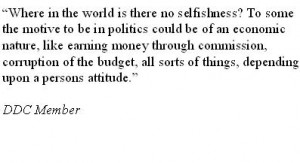 It varies greatly, though, to what extent pure unilateral self-enrichment is possible. Take the VDC Chairman who organises a user committee to implement a project. Quite often, the user committee is comprised of “close” supporters who often expect a share in the “profits” of the misuse.
It varies greatly, though, to what extent pure unilateral self-enrichment is possible. Take the VDC Chairman who organises a user committee to implement a project. Quite often, the user committee is comprised of “close” supporters who often expect a share in the “profits” of the misuse.
Many supporters – relatives and friends, good neighbours, “close” party workers, teachers and village leaders, indeed all kinds of “afno manche” – will expect some degree of inclusion in the sharing of the profits, and if too disappointed or ignored many will begin to reconsider their position as supporters.
Self-enrichment occurs but in many communities it takes place through a greater accommodation of supporters and other interests. Add contractors and even line agency staffers to the list. Just take the overseers who must approve the work done: they too will typically require a share of the proceeds.
It’s also true, though, that where a local strongman is in control, and the far majority of the locals are comprised of very poor and less educated villagers, a small select group can be able to secure the profits to themselves. This can also be achieved through secrecy and protection by “higher-ups”.
Chapter 16: Bureaucracy: Friend and Foe in Local Politics
It’s difficult to understand local politics in Nepal, we have at least found, without also taking a closer look at the involvement of bureaucracy and its less visible links to parties and politicians. Many local politicians interfere with bureaucracy – and many staffers, in fact, interfere with political matters, too!
Bureaucracy is supposed to be separated from parties and politics: politicians are formally meant to make decisions and staffers to implement and execute those decisions. That’s the formal system in short. But political interference, and staffers manipulating the rules and regulations, are common.
Local politicians have to engage with bureaucracy in their district in various situations. The bottom-up planning system is just one stage at which they need to work with staffers. They interact with staffers in many other situations – often trying to influence or even control them – and in informal ways, too!
Politicised Bureaucracy: Staffers with Political Affiliations
Interference occurs first of all as politicians – at all levels – post staffers to serve their interests. When a new government takes office, it typically shuffles positions to its advantage, and as a result chief officers and even lower staffers become linked with parties and politicians.It occurs as follows: if the previous government put staffers into positions loyal to its party – and that’s often the case – the new government will immediately transfer those staffers to other positions or different parts of the bureaucracy and replace them with staffers loyal to their party!
Officers at the line agencies in the districts, even teachers at the local schools, are then posted and transferred politically. There can be managerial or technical reasons to move staffers too – and sometimes those reasons matter – but political motives are very common.It even happens that line agencies become locally known by a party affiliation. Local politicians notice when a Chief Officer listens more to one party than to another, or when a teacher at a school promote one party more than another. In those cases, they know which office or school is more on their side!
Local politicians, on their part, frequently go to the line agencies for resources. If the budget for the school project ran out, they’ll go to the line agency for education, or if the road deteriorated, they’ll go to the line agency for roads and transport, and so on. You’ll often see a lot of coming and going.
But it’s typically very difficult to get access unless you have a link or connection into the line agency. If you don’t, staffers will refer to the “rules and regulations” – they turn down many requests for resources in the course of the year – but if you do have a link, they often say yes!That’s why parties in power post staffers at the line agencies who are loyal to them and their supporters. Staffers are also given positions by politicians as benefits or rewards: if you’ve served the party, you might be rewarded with a position. But you’re also obligated to serve the party back: serving the party is part of the deal!
Staffers’ Hidden Interest: Collecting Commission
Staffers, however, will not always do what the party asks, though they may have an obligation. It’s well-known that inside Nepalese bureaucracy is a hidden interest which continues to play a role no matter how often the government changes or new parties come and go: the interest in commission.
“Commission” is an amount “creamed off” of a budget, or a hidden “fee”, put in one’s own pocket. Bureaucracy is indeed supposed to serve as a bulwark against such a grave irregularity, but in Nepal – like in many other countries – it has only institutionalised this practice.In short, collection of commission is similar to the practice of corruption in the DDCs and VDCs. However, it’s a bit more sophisticated because it involves, not only one level – the line agency itself – but also superior staffers, even secretaries, at the ministries in Kathmandu.
One method of collecting commission is to inflate budgets and receipts. Manipulation of public tenders and contracts is another: collusion between staffers and contractors allows money supposed to be used, say, for construction work or public revenue, to be creamed off and put in the pocket instead.However, it doesn’t end there. Staffers also collect commission from ordinary citizens who come to the line agencies for civic documents. A citizenship card at the CDO’s office, or a land deed at the Land Registration Office, to take two common examples, is sometimes issued only if you pay a commission.
The money collected at the line agencies is typically not kept there but shared with superior officers at higher levels. Local politicians, contractors, and staffers themselves have described this practice to us, and it’s been sketched by observers of bureaucracy in Nepal. It’s a whole network.Commission money channels up through this network where it’s shared in variable portions at the different levels. Staffers who perhaps refuse to participate will typically be regarded as obstacles by those who are sharing in the “profits”. It’s expected that subordinates do it and superiors protect it!
Local Politicians and Staffers: Conflicts of Interest
It’s not easy if you’re a local politician who wants to build a school or gravel a road back in the constituency and staffers at the line agency want to cream off a percentage of the budget. How are you going to complete the project if part of the money is separated for commission?It’s of course also a conflict of interest if the local politician was actually planning to allow his own user committee of supporters to cream off an amount. If the staffers already took out a big chunk as commission, there would be less for the politician and the supporters to share.
Those are two common conflicts of interest, but local politicians and staffers can also have interests in common. It might be that both see a benefit in completing a project well and in time, perhaps to impress “higher ups”, just as it can also happen that they join hands to cream off budgets together!
Parties in power transfer and post staffers to maximise access to the line agencies for their local politicians, just as individual leaders post staffers to follow their personal decisions. However, there is a limit to what a politician can do in the face of the staffers’ network.It’s almost a universal fact that bureaucracy is not only a place of rules and regulations, but also of manipulation and secrecy. In Nepal, the secretaries, who have typically served for decades, know the ins and outs of the bureaucracy, and that often enables them to stall political decisions if they want to.
Ministers in Kathmandu – at the behest of the party leadership, local politicians in the constituency, or other supporters – may issue orders to transfer difficult line agency staffers elsewhere. But if the secretary of the ministry disagrees, for whatever reason, the minister may have to change his mind!MPs and former ministers have told us about the dangers of upsetting the secretaries too much. The secretaries can have strong interests in keeping loyal subordinate staffers in their positions, and if you don’t respect that and other interests, they might create difficulties for you.
What difficulties would that be? Well, for instance, if your local supporters want to implement a project for which you have allocated resources in the budget – as a politician – the secretaries might issue secret orders to the line agencies in the district concerned to delay the project – as staffers.It is common, though, to make compromises allowing many interests to be met at the same time. Take big infrastructure projects: politicians and staffers tend to form the management committee in which the budget is creamed off and shared; contractors get a deal; and other supporters benefit too.
However, who gets to sit on the management committee is not always the result of a compromise. Whichever party or faction is in power will tend to select their own close supporters, and to make sure that staffers loyal to opposing parties or factions are not included. This – in turn – can be a struggle.
Chapter 17: Struggles for Power: Local Politics at Its Most Intense
Political struggles – or struggles for power – mark also local politics in Nepal. Why don’t the politicians put all the bickering aside? Well, however much this question is asked – and answered – political in-fighting seems to continue unabated, whether you look at Kathmandu or the local level.
It’s all about the power: the feeling of enjoying power and keeping it to oneself, some say. Others suggest that the struggle for power has to do with a strong interest in sharing in the corruption. Political parties and individual politicians, who cream off budgets, may want power for that reason.
Control is clearly of importance to politicians in districts and VDCs, we have at least found, not necessarily for such motives as “power” or “self-enrichment” alone, however, but also to be able to benefit supporters. If you’re in control of resources, it’s much easier to channel down benefits!
How do local politicians struggle for power? In many different ways. Let’s look at the main methods.
Power Struggles in Local Governments: Methods of the Minority
The majority in the DDCs and VDCs do not face the same situation as the central government. It cannot be overthrown by a majority in the local legislative body – the District and Village Councils – like can the government in parliament. You cannot vote the DDC or VDC Chairman out of office.
But that doesn’t mean the minority can’t try to put a struggle when it’s excluded from a share in the budget or, say, when the majority is misappropriating the budgetary resources in favour of its close supporters. In fact, power struggles are common: they begin with shouting and can end in a fight!
It’s relevant to look at some of the methods in between these two ends of the spectrum: shouting at the meeting across to physical confrontations. One very common method is for the disgruntled politician – such as a Ward Chairman excluded from the budget – to gather a group or “delegation”.To gather a delegation of villagers and go, say, to the VDC Chairman can be an effective means of pressure. Just imagine how a VDC Chairman might feel when an angry Ward Chairman enters his house in demand of a share in the budget and a crowd of people is shouting outside. This can work.
It might also fail, however, all depending on the delegation and the susceptibility to pressure of the VDC Chairman. But the same Ward Chairman might then use any links and connections he might have at higher levels. “Higher ups” might be able to intervene on his side, exerting further pressure.It’s also true, at the same time, that if a VDC Chairman, for example, enjoys even stronger links and connections, which may be the case, the Ward Chairman will likely have little luck in his efforts. In fact, in most cases, the minority in the DDCs and VDCs make protest in vain and the majority wins.
Playing Two Factions out against Each Other
It can happen that the majority is divided into two factions opposed to one another. In this situation, even a hitherto excluded minority may suddenly enjoy great influence. But why would the majority split into two? Well, two leaders might have quarrelled, or the party might have split in Kathmandu.
It’s common that when the party splits – or divides informally into two factions – at central level, so it typically does at the local level, even down to the level of the VDCs! Where all members of the party at local level side with the same faction, it will stay together; where it doesn’t, it will split up.The minority will typically exploit this situation by playing the two factions out against each other. Typically, neither faction will have a fifty-percent majority, since the party split into two, and as a result they will each depend on the support of the minority, which will sell this support for a share!
Splitting Organisations and Creating New Ones Party-wise
Local politicians can be found in many other organisations than the local governments and party committees. User committees are just one other type of organisation in which you’ll typically find politician. Add school boards, forestry groups, dairy and temple committees, and that’s just some.Politicians at district and VDC level quite often hold positions in a couple of local organisations. Hospital boards, local chapters of Red Cross and Rotary Club, road committees, and, say, bazaar committees, are additional examples. Power struggles between politicians often occur here too!
It’s especially common to witness conflicts in the context of local school boards. In so-called School Management Committees, many decisions of political importance are made. Committee matters are not only about everyday management of the school but also recruitment of teachers.Schools have split as a result of conflicts about whether to accept a teacher posted by the central government or not, as well as over teacher allocations made by the local governments. In one VDC we visited, the party in minority had simply left the school board and founded their own school!
In other VDCs, we have seen how dairy committees – small associations of milk producers – split party-wise as a result of similar conflicts over use of resources. Where there was only one dairy committee in each ward in the past, suddenly there were two: one committee for each main party.
Refusing to Participate in the Other Party’s Projects
Politicians from different parties or factions also struggle for power by refusing to support and participate in each other’s development work. If one party launches, say, a road maintenance project, the other party and its supporters may refuse to help with it even though they’ll use it too.
Sabotage of projects even occurs. Supporters of one party might go and smash up the work done by the other. We have learned of such cases in water intake projects, in which disgruntled politicians and their supporters cut the water pipes, and in electricity projects, in which they stole the poles!
Motives to resort to such confrontations will vary. Indeed, it’s well-known that local hostilities that are actually about something entirely different – like old neighbour disputes or family feuds – can erupt in apparent party conflicts. But many local politicians will tell you about an additional motive.
It’s a simple calculation which is about support and popularity. If a party launches a project in the community, it will gain popularity, whereas the other party, even if it helps doing the work, will get less credit. Obstruct the project discretely, however, and the popularity gain has been prevented!
Majority Projects Cases of Cooperation: When Supporters are the Same
It’s also true that opponent parties and factions sometimes do cooperate around a project. It can occur, at least that we have seen, in two main situations. One is when two otherwise opponent politicians realise that they can both benefit simply because both their supporters will appreciate it.
In a typical example, three Ward Chairmen – all from opponent parties – lived along an old track from a valley to a ridge. They were opposed to each other in the VDC in general. But when they realised that all their supporters liked the track to be turned into a road, they began to cooperate.
In contrast, they competed fiercely with each other over resources of utility only to their own ward. It’s a common characteristic that the politicians struggle for control and influence with each other when the needs of their supporters differ but cooperate in those quite rare cases when they coincide.
The other main situation in which cooperation occurs is when the majority prefers to avoid conflict. They might have been faced with fierce confrontation previously. Or they might just feel better by allowing the minority a share in the particular case. Budgets are then divided for that reason alone.
Struggling with Bureaucracy: Confronting the Staffers
Power struggles are not exclusively an activity between opponent politicians. If it’s kept in mind that the staffers may even side with a party, and serve it quite loyally in many cases, it may be less surprising that politicians and staffers can also end up at loggerheads with each other and struggle!
It’s not a power struggle in the conventional sense, and yet it’s to a high degree a struggle for control. Many local politicians confront staffers who, say, cream off the budget meant for a local project, take commission from a politician’s supporter, or say “no” when asked for an extra budget.Politicians confront the line agency staffers using the same methods as in power struggles in the local government. It starts with shouting and can end in physical confrontation. A common method in between these two is to go in a delegation and another to seek support from various “higher-ups”.
Staffers have told us how difficult it can actually be to turn away a delegation of villagers who show up with local politicians at the office and make demands. It’s not always easy to deny access when you’re confronted with them face to face. A delegation does not always work but it sometimes does.If the local politicians have links and connections at higher levels, the staffers can end up in a situation where it’s even more difficult to turn down the local demands. MPs may speak to the minister, who may in turn speak to the secretary, and from them an order may come to cooperate.
It also happens, however, that even higher ups can’t help – this is the case if the higher up are not in power or lack influence – and in those cases local politicians are sometimes seen to threaten and even attack staffers. It’s not common, but we have recorded cases, and it can sometimes work too.
Going to Kathmandu: Local Issues in the High Halls of Power
It’s important in a crash course on local politics to also note how short the distance can actually be between central and local level. MPs spend a great part of their time on helping supporters from the constituency, as we have talked about earlier. They make demands in parliament reflecting just that.
 MPs will also go around to the ministries, the National Planning Commission, and other offices at central level – frequently alone, at other times with local politicians, even with whole delegations, in tow – asking for resources needed to provide benefits. MPs often need to do this to stay popular.
MPs will also go around to the ministries, the National Planning Commission, and other offices at central level – frequently alone, at other times with local politicians, even with whole delegations, in tow – asking for resources needed to provide benefits. MPs often need to do this to stay popular.
It’s also true, of course, that MPs need to focus on national issues of legislation in parliament. Indeed, that’s their primary formal role! MPs that we have met also do this at least to some extent. However, they also told us that unless they work to serve local issues, they’ll lose local support.
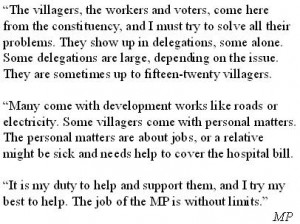 In short, hundreds of local politicians and other supporters go to Kathmandu everyday, although there’s no official count. It’s no surprise when you think about it: the needs are particular and local but the bulk of the resources and most of the decision-making power remains at the central level.
In short, hundreds of local politicians and other supporters go to Kathmandu everyday, although there’s no official count. It’s no surprise when you think about it: the needs are particular and local but the bulk of the resources and most of the decision-making power remains at the central level.
So, pressure which emanates from the local level and reaches its climax in Kathmandu, is brought to bear on the politicians in the “high halls of power”. It’s not only the interests of pockets of voters, party workers, local contractors, and so on, that reach this level, but also those of discrete groups.
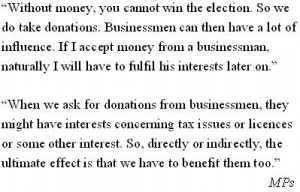 Interests groups who funded the party locally, or who gave donations to the individual politician, will ask something in return. Whatever they ask, and however legal or illegal the benefit might be, it’s difficult for the politicians to say “no” if they want future support, even if it’s a criminal group.
Interests groups who funded the party locally, or who gave donations to the individual politician, will ask something in return. Whatever they ask, and however legal or illegal the benefit might be, it’s difficult for the politicians to say “no” if they want future support, even if it’s a criminal group.
In the same way as all roads led to Rome, all links and connections, and all demands that cannot be met locally, typically travel upwards through various networks to the central level in Kathmandu. Here party leaders, MPs, ministers, and other higher ups struggle to get a share for their supporters.
Of course, they also struggle for power – party against party, faction against faction, even politician against politician from the same faction – to serve the interest of actors at the central level. Think of wealthy business houses, even foreign interests, and you’ll have an idea of who they seek to serve.
Booth Capture and Election Violence
Elections are supposed to organise and regulate political competition. It’s indeed the hallmark of “democracy”. But in all previous elections – albeit more or less reported – elections in various constituencies have been “stolen”: candidates have captured the voting booths and used violence.
It’s something that can occur locally, but it also happens as highly coordinated events in which MP candidates, District Party Committees, and party workers at VDC level plan and strategise with a view to employ such methods. We have come across many examples, two just outside Kathmandu!
It’s not least in cases of booths capture – of barricading or in other ways securing the voting booths and ballot boxes – that central and local agendas link together: the agenda of making the candidate win at all costs. If the opponent seems to have gained more support, booth capture is the last resort.How is it done? Well, there are a number of methods. One quite common approach is in addition to local party workers to call in so-called “rowdies” or “hooligans” – young men from town, perhaps from a karate club – who can deter the party workers and even the voters of the opponent candidate.
We know of cases in which the party capturing the booth had distributed yellow ribbons to their voters beforehand so as to allow the rowdies to easily distinguish supporters from opponents on the election day. Police, posted by the party in question, have been seen to help by turning a blind eye.
It’s also a common method to create a riot at the line-up to the voting booths, scaring away many voters, just as filling the ballot boxes with pre-printed ballots in favour of the candidate also occurs. Violence is often reported, and more recently “threats of violence”, which can work just as well.
MPs, ministers, DDC Members, Village Party Chairmen, indeed all politicians that we have met, regret the use of booth capture and election violence. But they also explain that it’s used, not necessarily because it’s preferred, but because where links with voters are few it is the only way!Imagine the effort of party workers up to the election; their hope to get benefits afterwards; the businessmen and other contributors who have donated money; the party leaders who wished for the candidate to win because he is a “close” supporter. With all that investment, it’s hard just to lose.
This is the point where we might say: but it’s part of “democracy” to accept the voters’ decision! Indeed, that’s true. However, unlike in some wealthier countries, losing or winning the election is a matter of economic well-being and future opportunities of the candidate and his many supporters.
Politics – and that goes for local politics too – is the arena where you get access or are left without. There is no “government welfare system”, no “unemployment benefits” to speak of – only who you know and who have links and connections. This is important to note, we find, to understand all this.
Chapter 18: Other Aspects of Local Politics – Feel free to Add!
We have not aimed to cover everything with this crash course on local politics. In fact, as stated in the introduction, local politics is a very complex topic. If you go and look closer, say, at the local party branches, NGOs, community groups, or the bureaucracy, you might soon add more aspects.
If you feel like it, add any aspect under this section you happen to find interesting. We have already put up one headline, just to illustrate how we have indeed not touched on everything in this crash course. Send us an email with an attachment, or use the comment box below, and we’ll include it!
Rowdies Used in Public Tenders
Contractors often compete vigorously in public tenders at the DDC office and the line agencies. It’s only well-known in the Contractor Associations that even though they might try to arrange the bids, so as to ensure that members win a tender at least once or twice a year, some will try to manipulate!
It can come to clashes at the tender submission day. Contractors who enter from outside the district, or local contractors bold enough to go behind the back of the associations, are known to take advantage of any links and connections they might have at higher levels or at the line agency itself.
Contractor cartels – formed in the contractor associations – will not always accept this. Some take rough measures to prevent the solitary contractors from submitting their bids to the staffers. How do they accomplish that? Well, we have observed one method several times: they send in the rowdies!
Rowdies, such as members of the local youth club, youngsters from the karate club, even policemen (dressed in civilian clothes), take up positions outside the DDC office or line agency, trying to scout out the solitary contractors in time. Or they are sent after the contractors after the tender submission.
It can come to harassment of the staffers, who are receiving the bids, as well as of the contractors thought to collude with the staffers. Staffers do accept bids under the table from solitary contractors. We have seen it twice. Sometimes, the rowdies catch the contractors, and some are even beaten up.
Chapter 19: Comparative Observations on Local Politics in Nepal
Is local politics in Nepal unique? Well, politics in any country will have some unique aspects to it. However, judged from what we have seen elsewhere and read, it’s also clear that local politics in Nepal has some quite common characteristics. The terms are unique but the characteristics less so!
“Afno manche”: Loyalty and Obligations among “One’s Own People”
Go to any country with a poor rural society like in Nepal – elsewhere in Asia and even in Africa – and you’ll find something similar to the social relationship of “afno manche”. The family and other “close” relationships have even meant a lot to people in large parts of Europe in earlier times.
It’s simply the norm in many poor societies to help the family and others who are “close” and to expect help in return in times of need. In countries where government services are very limited – unlike in many western countries – those who are close are simply those you rely upon the most.
“Chakari”, Big People and Small People, and Patronage
It’s also common to find relationships that resemble the one between a “thulo manche” and his or her applicants: between “big people” and “small people”. Here we know of many examples from Europe, not least in the Mediterranean region, where it’s been called “patron-client relationships”.
The discovery of “patrons” and “clients” in numerous countries outside the Mediterranean region, across most continents, in fact, but not least in poor rural societies, was made first in anthropology and later in political science decades ago. It is an extremely common relationship in many societies.
In societies where it’s prominent, it typically also plays a big role in the relationship between parties and politicians and voters and other supporters. Many people will vote thinking of the politician as a “patron” and themselves as “clients”: in return for their support, they expect the politicians to help!
Politicians need control of resources to be able to provide benefits that meet the often extremely particular needs of their “clientele”. As we have seen in Nepal, one village may need a road, another a classroom, and so on. In a term, they need to be able to distribute “patronage” to remain patrons.
“Bhaan-sunn garnu”: Networks of Speaking and Listening
It’s equally common to find networks in poor rural societies which – like in Nepal – are made of a mix of relations between patrons and clients and circles of relatives, friends, and other “afno manche”. These networks are based on acts of reciprocity and extend from local to central level.
Politicians in Nepal refer to the networks with the term of “bhaan-sunn garnu”: speaking or listening. But in many other countries with poor rural societies, the very same type of networks have been described as “brokerage networks”: networks held together by actors called “brokers”.
Brokers are simply all those who – in the Nepali vocabulary – listen to the “small man” and speak on their behalf to the “big man”, hoping to access the resources needed to help the former. The “runners” are a typical example of especially active brokers. They exist in many other countries too.
Area Politics: Favouring Supporters in the Constituency
Politicians all over the world – also in many wealthier countries – focus a great deal on interests in their own constituencies. What those interests include differ greatly. Take the U.S.: here you might have big companies, churches, or wider segments of voters to think about. Congressmen do that!
It’s well-known even in my own country, Denmark, that MPs especially from some parts of the country like to promote the interest of their constituencies in parliament. Local politicians do it too, notably after the areas of the municipalities were enlarged. They think of their own “pocket areas”.
It is in poor countries, however, that politicians have the greatest tendency to invest most of their energy and time in accessing resources for diverse supporters back in the constituency. Once upon a time, when Ireland was much poorer than today, you could find the exact same behaviour there!
Politicisation of Bureaucracy
There is also nothing unique about a politicised bureaucracy. The practice of shuffling bureaucracy at managerial and even lower positions has been observed in many other countries. Indeed, like in Nepal, you’ll typically find it where patronage and area politics are also common political practices.
Politicised bureaucracy – every new government putting into positions staffers loyal to the party – has been reported in countries as diverse as Greece and Cyprus, even U.S. and Canada, some half a century ago. Mexico is a famous example. But there are many others countries in which it is found.
Corrupt Bureaucracy: Networks for Collecting Commission
Bureaucracy is also strongly associated with informal networks for collecting commission in many other countries. It’s also not a characteristic unique to Nepal. It’s of course known all over India and the rest of South Asia and also in many parts of Africa. “Commission” speaks many languages!
It was once fundamental to bureaucracy under the king in Morocco. By allowing bureaucrats and other subordinates to share in the spoils was a way for the king to ascertain loyalty of his closest servants; exclusion from the network was an effective punishment. It was here a means of control.
Bureaucracy is indeed known to have been anything but formal and rule-based in older days in Europe. Once upon a time when Europe was still poor and rural, albeit some industrialisation had begun, positions in the bureaucracy were reserved circles around the king and handed out to them!
Power struggles over Control of Government Resources
It is also not unique to observe parties and factions struggling for power apparently for no other reason than to get control over government resources. The very same practice has occurred – and continues to be observed – in large parts of Asia, Africa and South America, as well as in former Soviet states.
Power struggles ravage between parties that are little more than brokerage networks. There are leaders who use whatever means at their disposal; and there are pockets of voters, party workers, contractors, loyal bureaucrats, even criminal gangs who as supporters encourage the power struggle.
Power shifts from one party or faction to the other with short intervals as the opposition at once throws itself at the next government in order to recapture power in the interest of diverse supporters. Or they form coalitions, or make power-sharing arrangements, in any case with the aim of control.
Questions for further consideration
We could draw more parallels – just think of vote buying and booth capture: those are not particular to Nepalese politics either. Indeed, if you would like to point out more similarities between politics in Nepal and other countries, feel free to post it below. We think all similarities are crucial to note!
Why are similarities important? Well, it remains a widespread ambition to address and change the way politics is practiced in Nepal, also at local level. There are many who would like to see a more “democratic” practice develop. But that’s another reason to consider how difficult that is and why.
If the practices of local politics in Nepal are common in poor rural societies across the world, it’s clear that we are dealing here with something that’s somehow linked with being poor and rural – not with Nepal in particular. Afno manche, patronage, brokers, and so on, are really widespread.
It’s clear, then, in length of this observation, that the behaviour might not be the result of a special Nepalese strain of politicians. It might just as well have to do with the conditions under which the politicians act: if the same behaviour occurs in similar societies, perhaps it’s something systemic!
Our intention here is not to conclude on this crash course on local politics with a grand “diagnosis”. We’ll be the first to recognise that to truly understand why Nepalese politicians act like they do, and why their behaviour persists, is a highly complex matter. That’s exactly why changing it is hard.
Politicians in Nepal are not all “undemocratic” in their mindsets and attitudes. Many find it very difficult, however, to part with the “old” ways of doing politics. Why is that: do they simply lack will or commitment, or are there conditions in society that make it difficult? We’ll leave it open!


